We had not realized that the sun would rise at 4:00 a.m. and wake us up despite the dark curtains we had pulled across our windows. When Michael got out of bed at 5:20, Nancy rolled over and asked, “Are you giving up, too?” So Nancy rose and showered, and then did some hand laundry while Michael set up his tablet and keyboard and started writing blog entries. By 7:00, we were ready to go downstairs (four flights—the elevator is small and slow) for breakfast.
We rarely stay in four-star accommodations in the States, so we realize that comparing the breakfast buffet at the Hotel Paris Prague to those at the Quality Inn or Best Western is like comparing apples to orange Skittles, but still: Why can’t American hotels do breakfast like the Europeans? And why can’t American restaurants wait a few days for the melons to ripen before they slice them up and put them on a serving tray? Today it was delightful to—as Michael put it—“eat fruit worth writing about.”
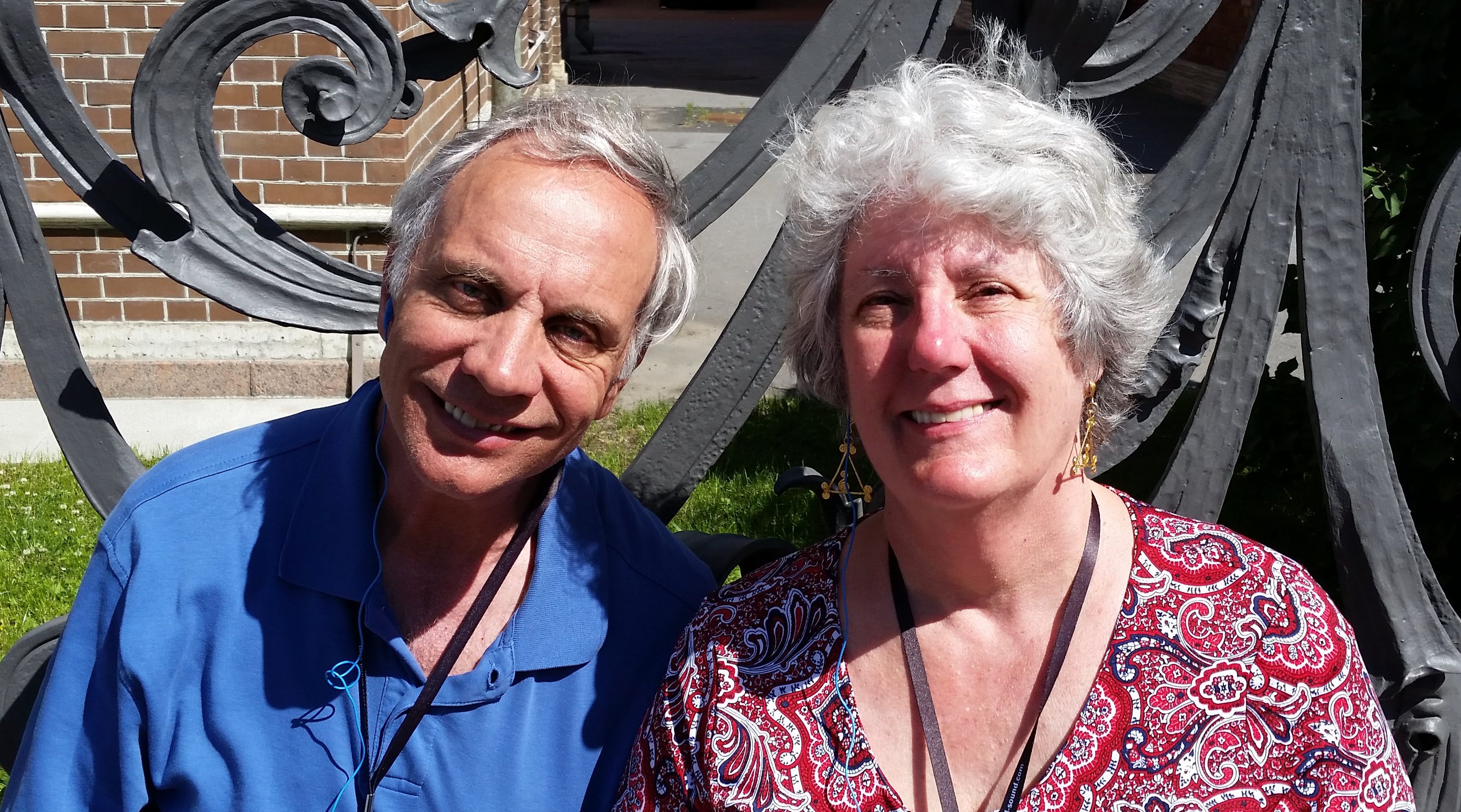
Mark and Lynn
This morning we shared the dining room with one of the several parties of Asians we had seen posing for wedding photos all over Old Town yesterday. (And “posing” is the right word here: the Chinese don’t simply stand still and smile, but carefully position themselves in alluring attitudes before directing the cameraman to press the shutter button.) More exciting than seeing the Crazy Rich Asians at breakfast was encountering Mark and Lynn there, too. These dear friends, who often have been our traveling companions in the past, moved to southern Utah in April, and we have missed them.
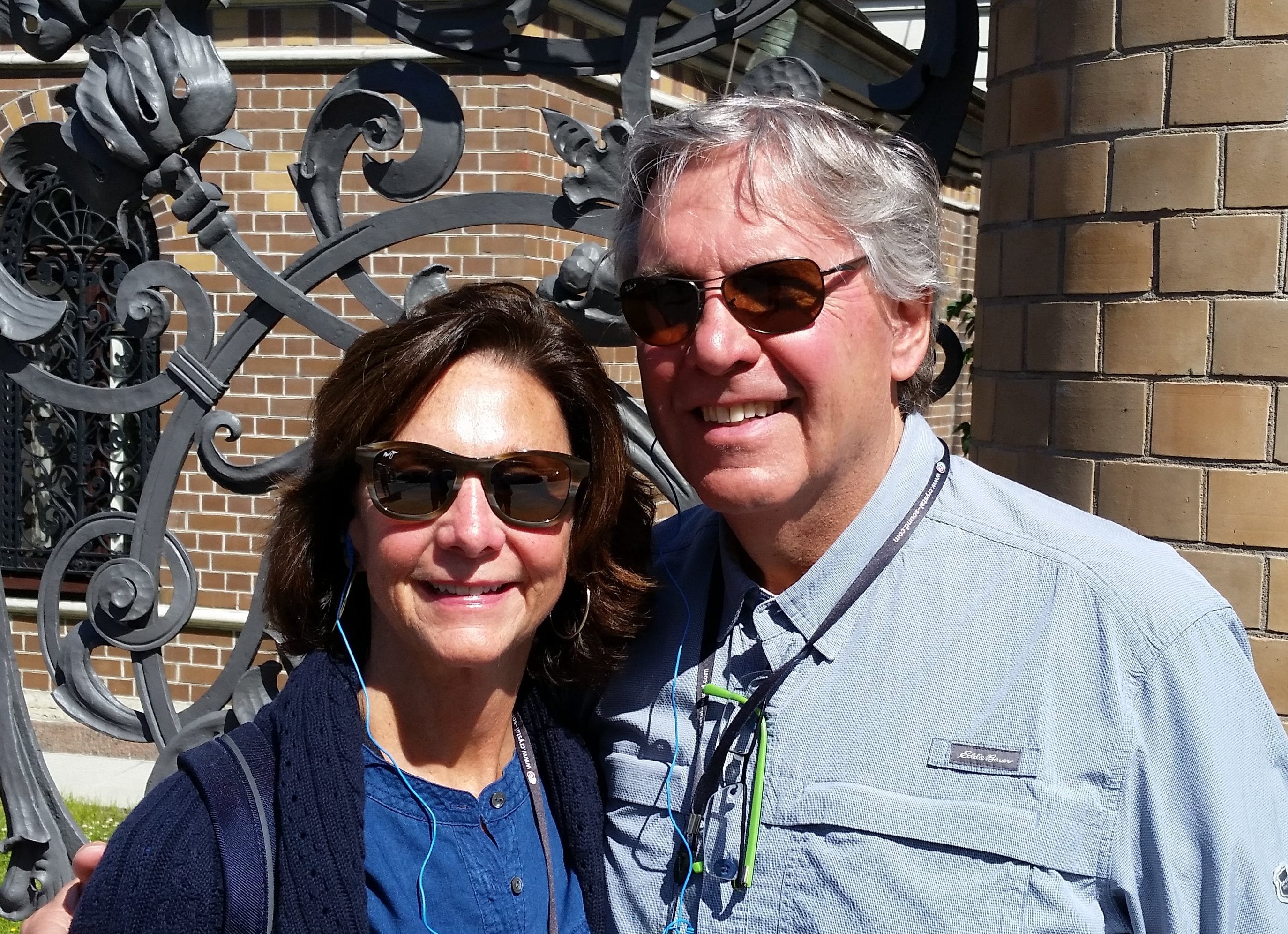
Jan and Steve
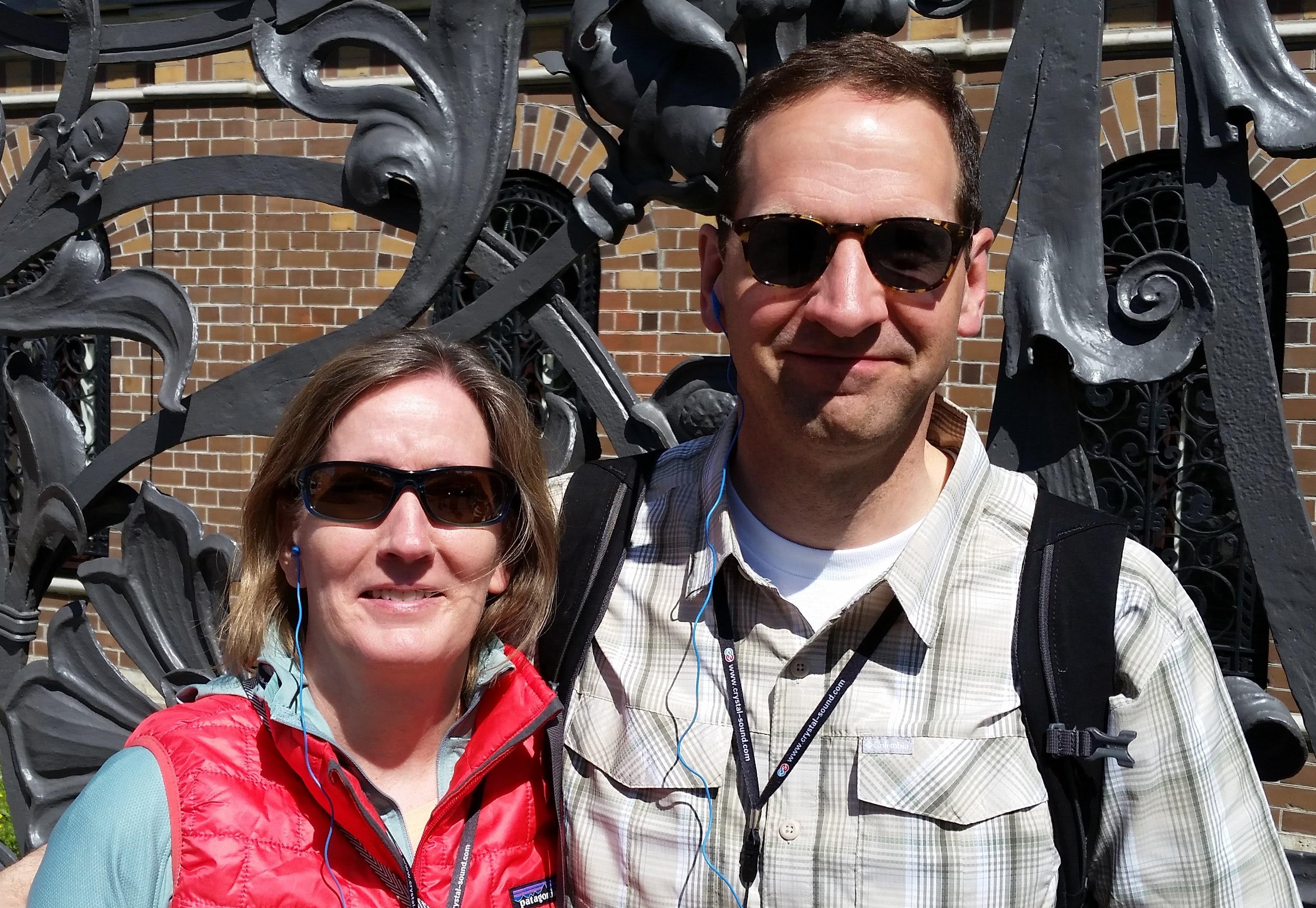
Lisa and Ed
Soon we were joined by more friends who had arrived last night: Jan & Steve, and Ed & Lisa, all of whom had come from Salt Lake City. By 9:00, our Prague tour cohort had assembled in the hotel lobby, ready to board the Mercedes 18-passenger van that was waiting for us outside.
Until yesterday afternoon, when Jim and Carol informed us that there would be a change in our itinerary, we had expected to spend our two days in Prague on guided tours of the city, today focusing on the right bank of the Vltava, and tomorrow on the left bank. However, on the recommendation of some travel-industry colleagues, the Gees had decided to condense our city tour into one day and add a day trip to Česky Krumlov, a well-preserved medieval castle town about 175 kilometres southwest of Prague, not far from the Austrian city of Linz.
Eva, our native guide, left no significant sights undescribed as we drove through the capital, and even when there was nothing but woods and farmers’ fields to point out, her commentary did not end. She began by briefly outlining the history of Česky Krumlov and the three noble families that had owned the castle, but as we passed Prague’s Břevnov Monastery she quickly segued to a discourse on the Czech brewing industry. Recently discovered archaeological evidence, she explained, confirmed that Bohemian monks had established a brewery at the monastery as early as 993 A.D. “Even today,” she went on, “the best beers are still made with Bohemian hops.”
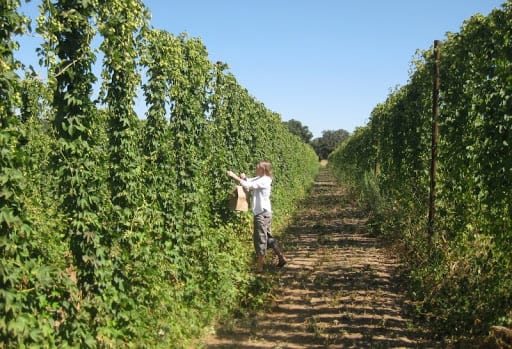
Hop vines are trained to grow vertically

When we inquired, Eva told us that hops grow in bunches like Brussels sprouts, but we think they look more like grapes
Next she told us all about the local gemstone mining industry. We had already seen a lot of garnet and moldavite jewelry displayed in Prague shop windows, so Eva told us how to recognize high-quality gemstones and bargain for the best prices. She also explained that in Bohemian folklore, the brilliant red garnet represents the earth, while the green moldavite—formed as a result of a meteor strike near the Vltava/Moldau River, and very rare—represents the sky.
Other interesting factoids shared in no particular order by our loquacious guide: 1) The Czech Republic’s unemployment rate is only 1.2%, the lowest in Europe; 2) The Czech coat of arms includes a lion with two tails that represent power; 3) Until the Nazi occupation, Czechs drove on the left side of the road, but because the Germans found that inconvenient, Hitler decreed that Czech drivers would now operate their vehicles on the right side (“The only good thing Hitler did for Czechoslovakia,” Eva laughed); 4) Besides growing wild all over the country, poppies are cultivated for their seeds—but not for opiates; 5) Though they were repeatedly betrayed by the Western Alliance before, during, and after World War II, and then again in 1968, when no one came to defend them against the Soviet invasion, the Czechs have maintained a positive attitude toward Europe as staunch supporters of the EU and NATO; 6) The Czechs are grateful for the independence they have enjoyed since 1993 and are dedicated to democratic rule, but they recognize that some aspects of the Soviet occupation—such as the institution of universal education and work requirements—were actually helpful, so they have tried to preserve those positive innovations within their current system.
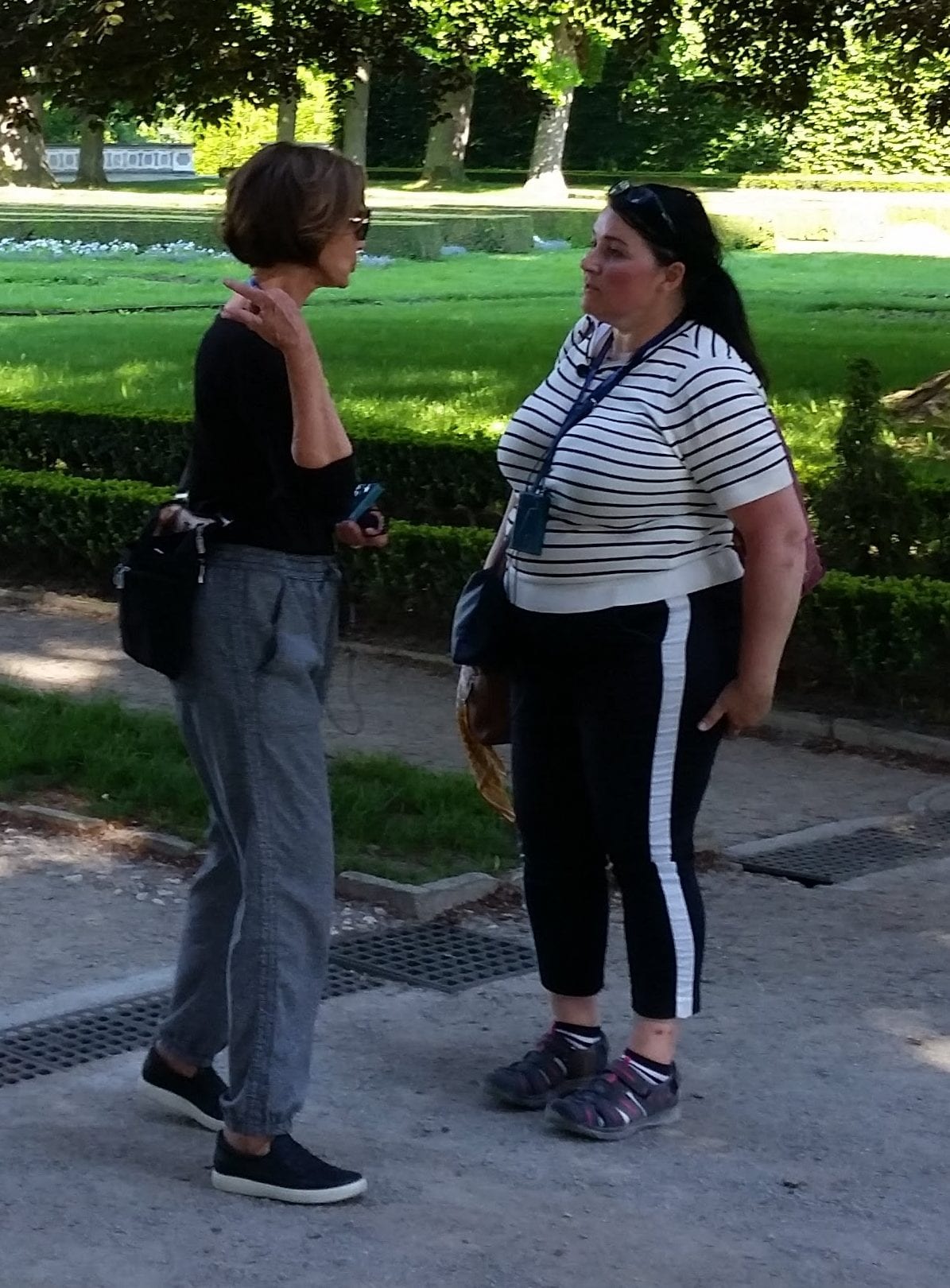
Linda talking with Eva, our Czech guide
In addition to providing random bits of relatively interesting information about her country (using the word actually as a meaningless interjection in nearly every sentence), Eva also shared some fascinating snippets from her own life, especially what it was like to grow up under Soviet rule. As a teenager during the 1980s, she was required to learn a variety of crafts and vocational skills, from knitting and painting to plumbing and carpentry, as part of her regular school curriculum.
“But even though they tried to indoctrinate us, actually,” she said, “I wasn’t really a Socialist. Actually, I had a pen pal who lived in Alabama. My mother was always afraid someone would notice that I was getting a lot of mail from America and we would be arrested.”
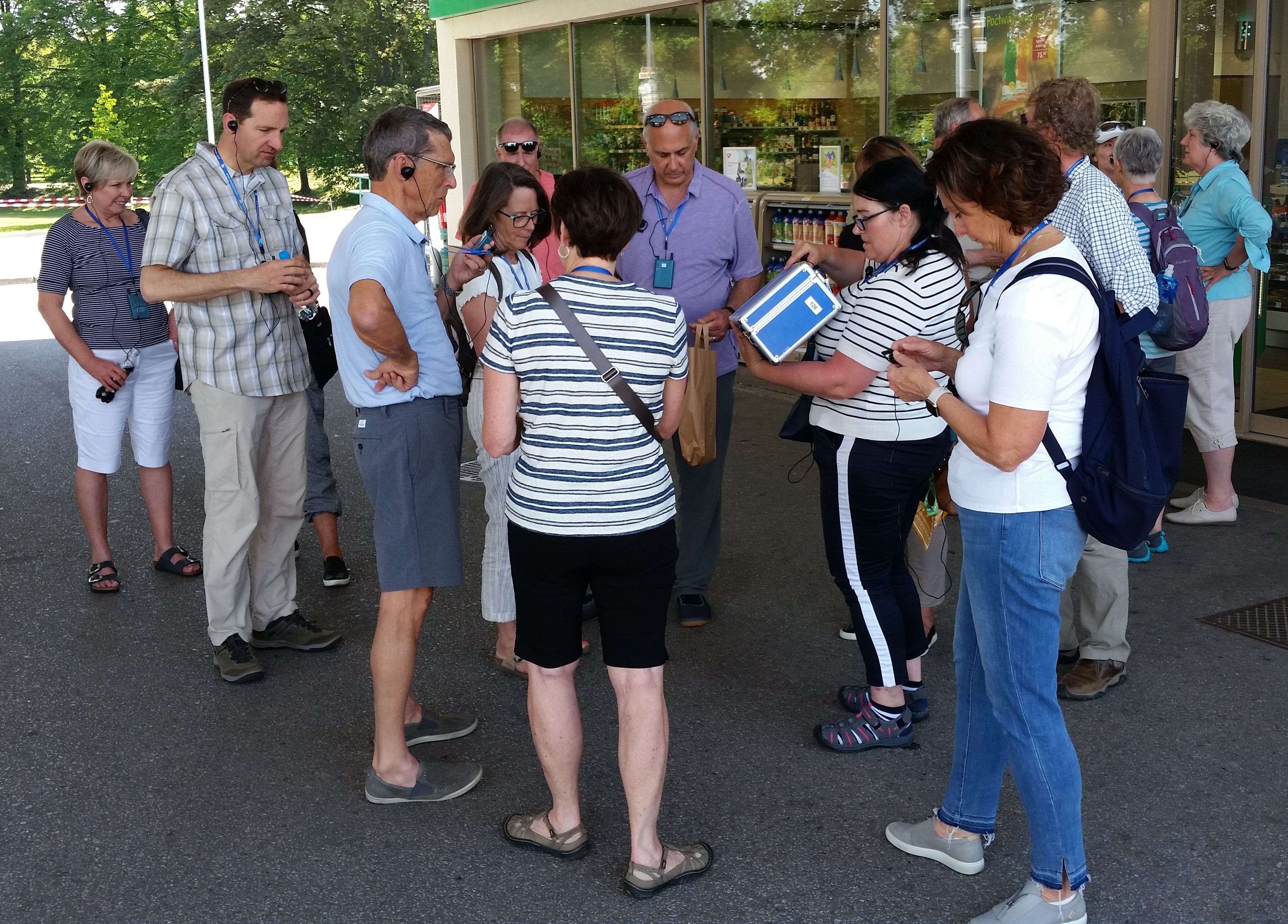
Performing a headset check during a bio break on the way to Česky Krumlov
But many of Eva’s personal revelations strayed into TMI territory. After learning that one of the couples in our group had recently celebrated their 42nd wedding anniversary (and that every other couple on the bus also has been married for at least thirty years), Eva launched into the tale of the torrid but ill-fated affair that made her an unwed mother fifteen years ago. “Actually, you’re all so lucky to have found your soul mates!” she exclaimed—to which Katie replied: “You don’t find your soul mate—you create them.” Tony (Katie’s husband) immediately rejoined: “Or you re-create your soul mate in your own image.”
The scenery on our 2.5-hour drive through the green, rolling hills of the Czech-Bohemian countryside was gorgeous, but we were happy to reach the even more picturesque town of Česky Krumlov, which is a designated UNESCO World Heritage Site.
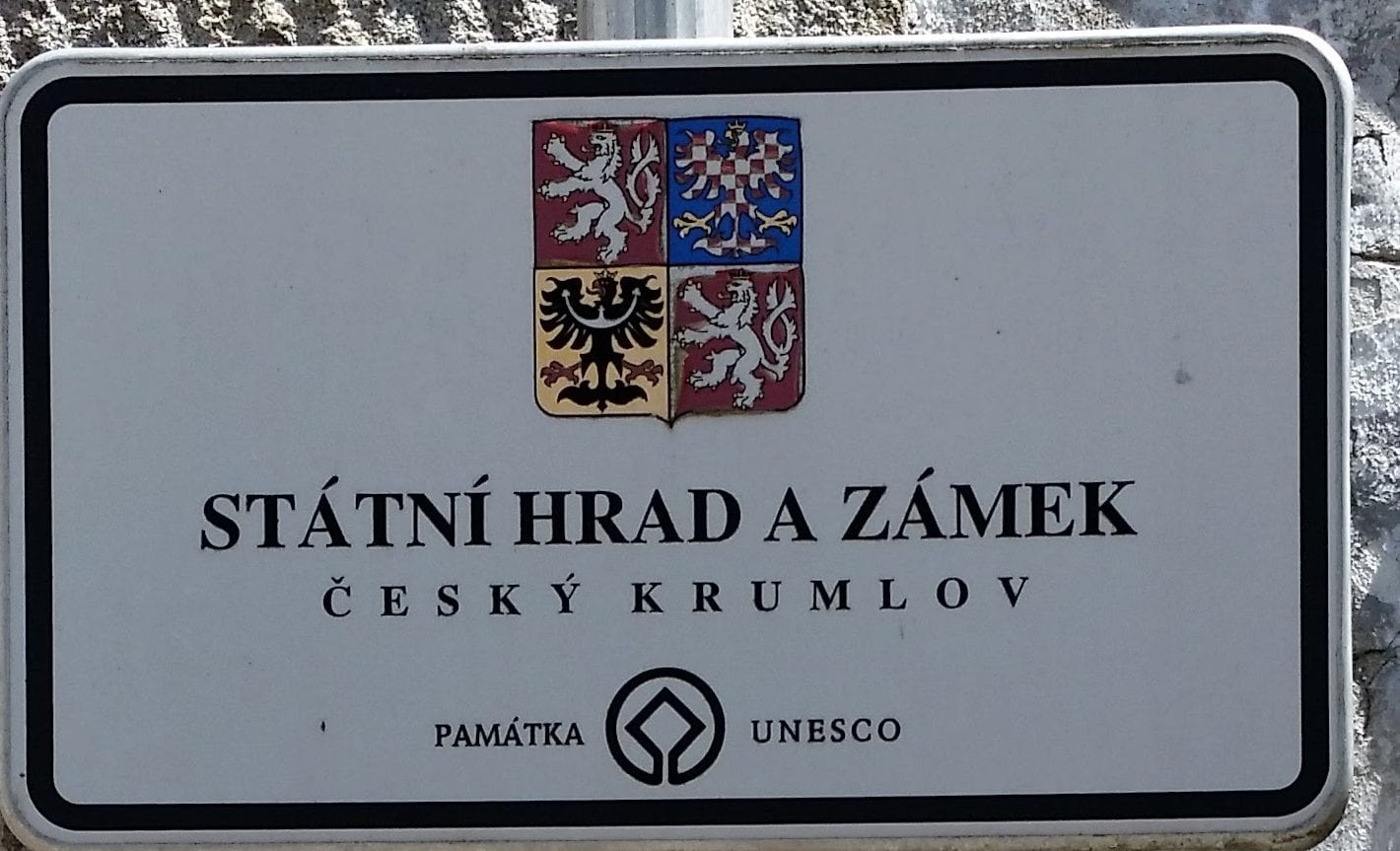
National castle and palace of Česky Krumlov
“When you’re visiting Europe,” said Eva, “you must learn the difference, actually, between a castle and a chateau. A castle (in Czech, hrad) would have started out as a fortress, a place of protection, actually. A chateau (in Czech, zamek, [or in plain English, palace]) is a luxurious place to live. Castles eventually became chateaus as they became safer, more comfortable residences, or a chateau could be built, actually, wherever a king or nobleman wanted to live.”
Česky Krumlov claims to be both hrad and zamek, the two functions so thoroughly interwoven that it is not easy to determine where one ends and the other begins. The first fortified settlement there was begun in 1240 on a bend in the Vltava River where a ford on an important trade route was located.
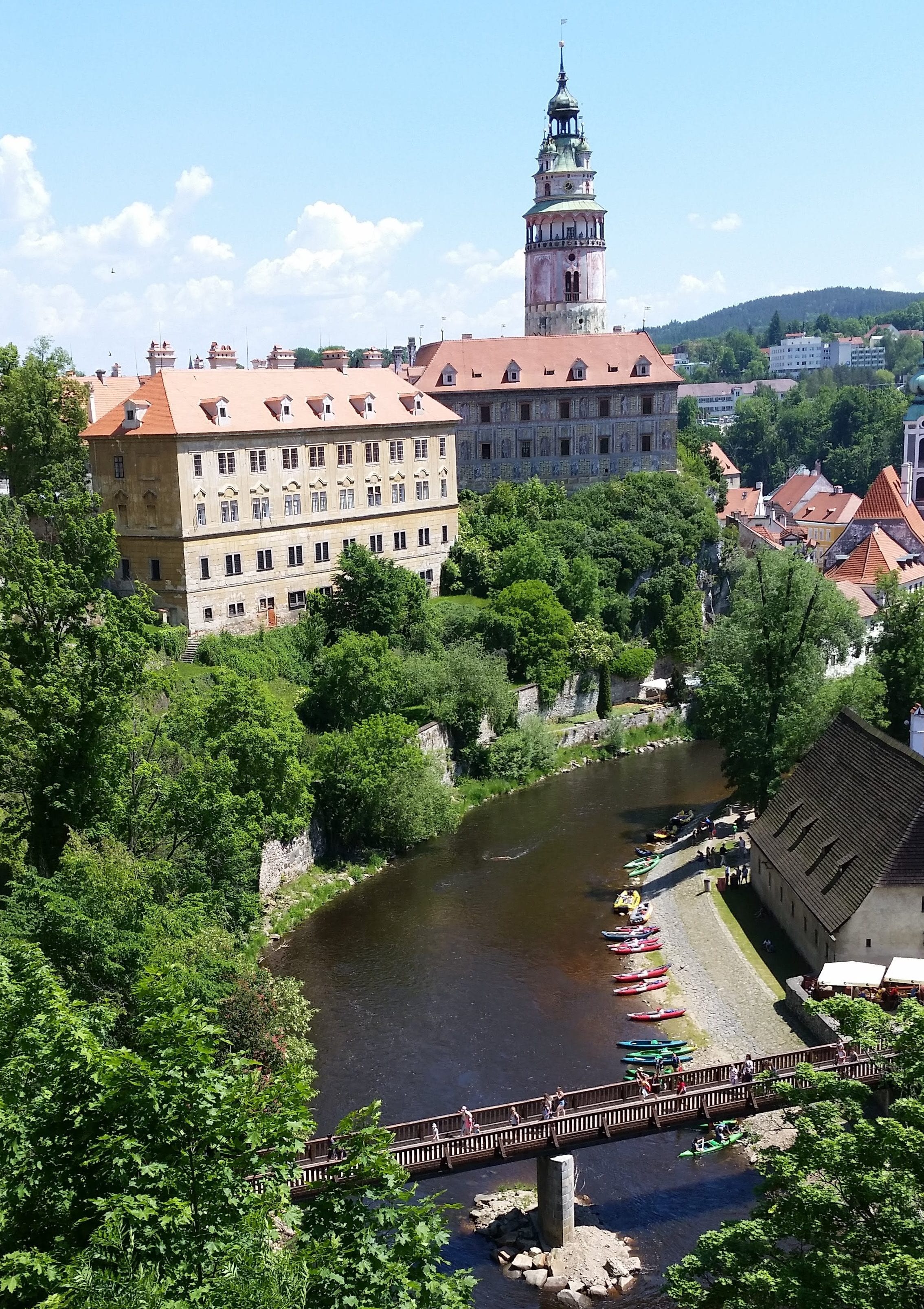
Česky Krumlov castle and the Vltava River
The family of the nobleman who founded the settlement died out a couple of generations later, so King Wenceslaus II of Bohemia turned the property over to a relative named Rosenberg, who was Lord Chamberlain to the king. The town prospered under the Rosenbergs, who transformed the castle into an elegant residence and held it for six generations.
By 1602, however, the Rosenbergs had become so financially overextended that they were forced to sell. The Habsberg emperor who purchased Česky Krumlov never used it, but awarded the estate to the Duke of Eggenberg in return for his support during the Thirty Years’ War. The House of Eggenberg held the castle for a century until 1717, when its last male heir died, and the property passed to the Schwarzenberg family. The Schwarzenbergs were still in possession of the estate when the property was nationalized in 1947.
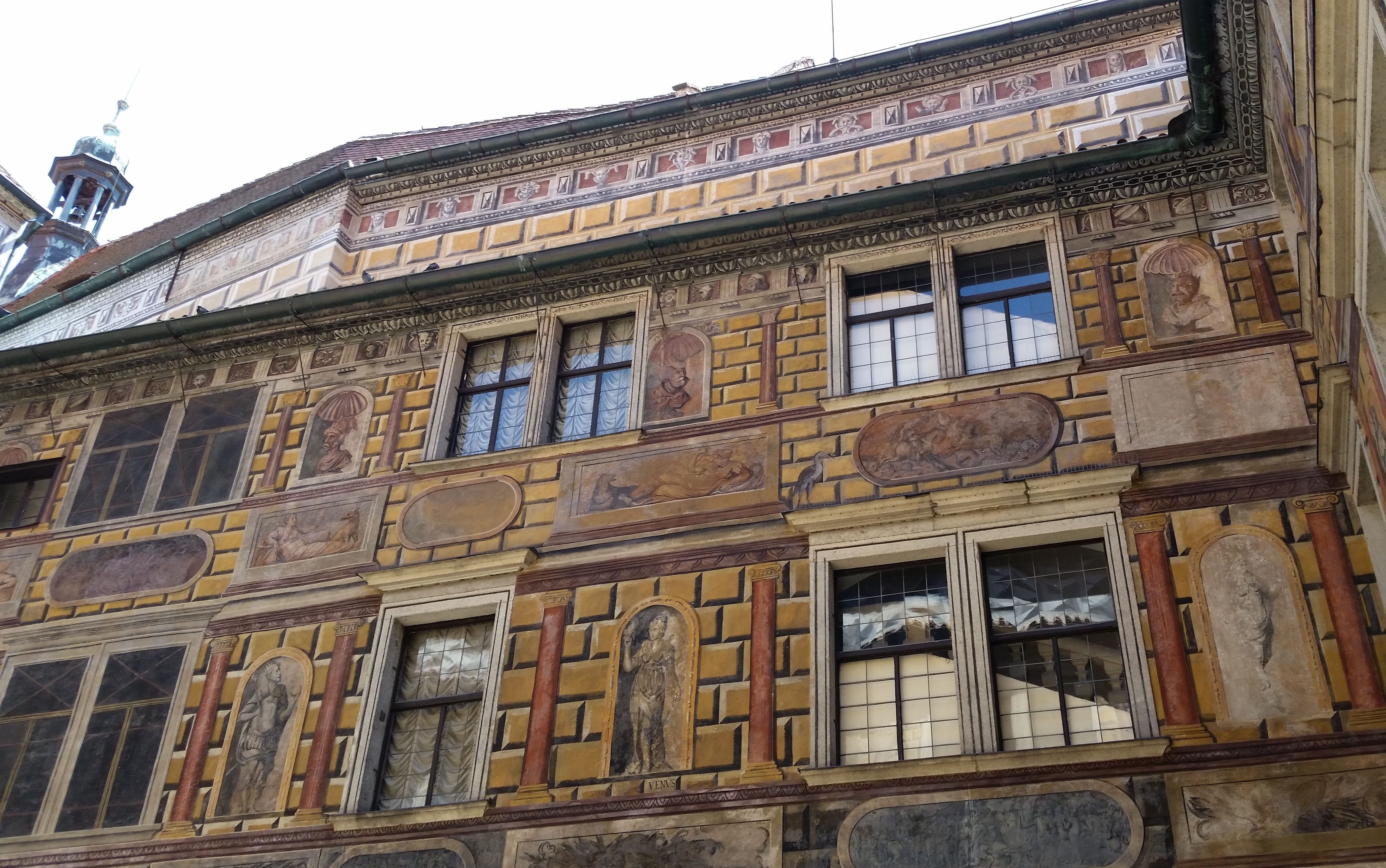
Castle compound exteriors were painted to look as if they were cut stone
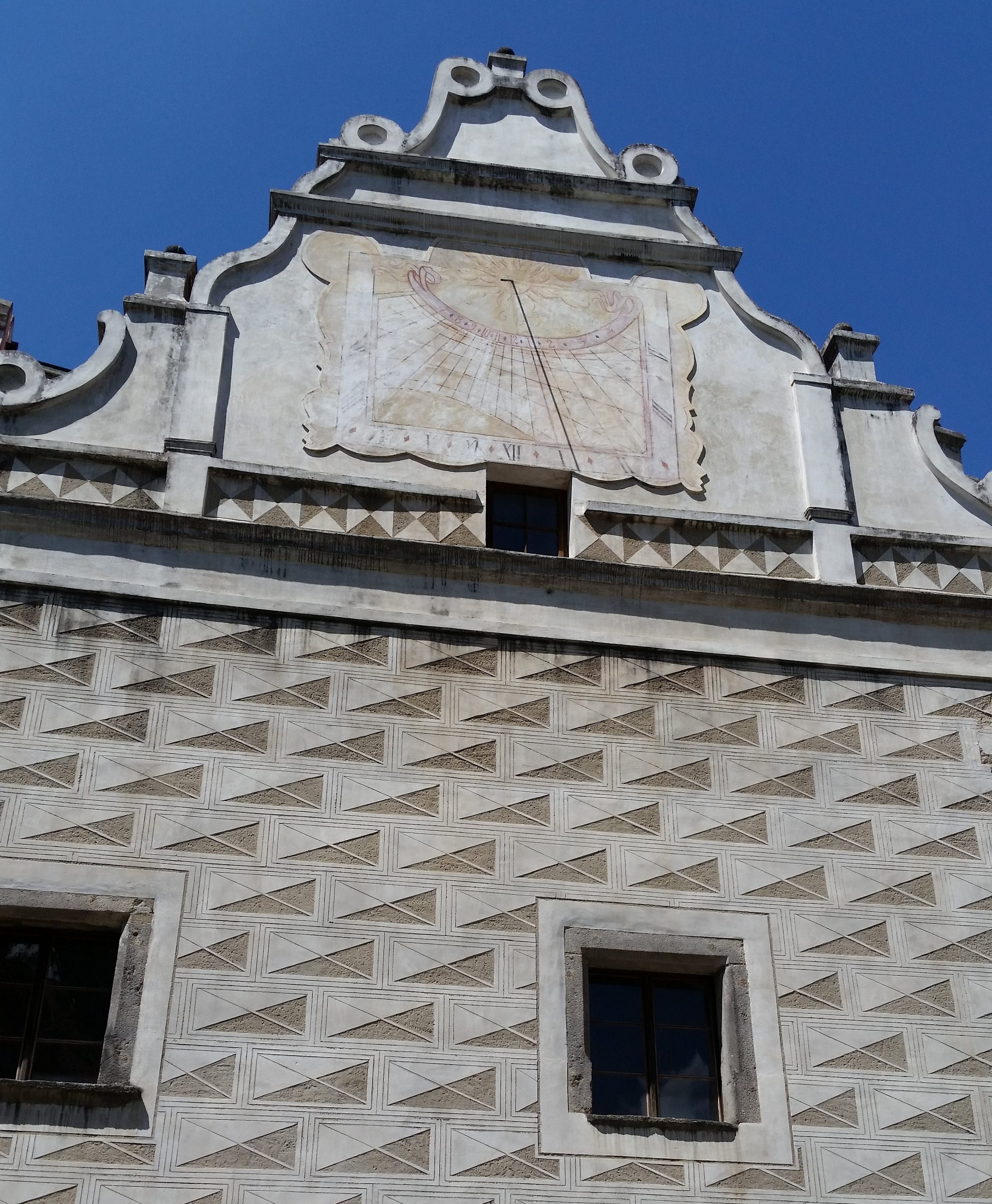
Faux stone exterior in the castle compound
It was about noon when we arrived in Česky Krumlov. After a brief walk around the castle compound, we were turned over to a young guide named Clara for a tour of the hrad/zamek. Unfortunately, photography within the elaborately decorated edifice is forbidden—mostly, Clara explained, because if every tour group was allowed enough time for everyone to photograph every share-worthy scene inside, forward progress through the castle’s narrow corridors would come to a near standstill—so we are indebted to various internet sources for some of the following photos.

Saint George’s Chapel
Our first stop was the rococo chapel, dedicated to Saint George, whose figure looms over both the vanquished dragon and a painting of the Madonna behind the altar. Clara directed our attention to the faux marble of the chapel’s walls. We were surprised to learn that painters had been employed to produce the imitation stone not because that was less expensive than installing the real thing—it wasn’t—but because genuine marble would have rendered the rooms too cold for comfort. The inside surfaces of many of the castle’s exterior walls were covered with heavy tapestries for the same reason. Most of these depicted the various owners’ successful military exploits, but the original sixteenth-century frescoes on other interior walls had biblical subjects. Several bearskin rugs no doubt helped prevent cold feet—although the bared teeth in their heads may have given some visitors cause to tremble.
Clara shared some intriguing stories about the castle and its residents. In the reception room, she showed us the Willkommen, a large porcelain tankard with a capacity of about two litres. Guests were expected to drink the entire contents in one draught, to loosen their tongues so the lord of the castle could more quickly determine the visitor’s true intentions. Anyone who failed to drain the tankard had to pay a penalty: sing a song, tell a tale, perform a dance, or provide some other extemporaneous entertainment for the rest of the party.
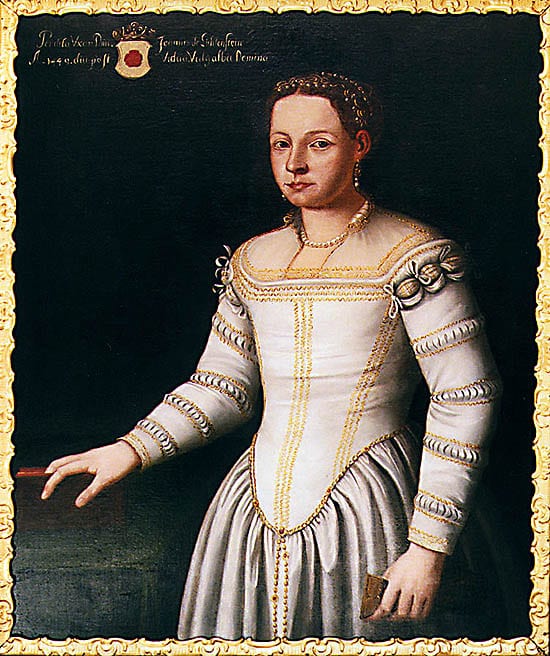
Perchta von Rosenberg
In another room, Clara pointed out a portrait of Perchta von Rosenberg (1425-1476), who was cruelly mistreated by the Moravian nobleman her father forced her to marry. When Perchta’s husband begged her to forgive him as he lay dying, she refused. The villain then uttered a curse: Perchta would spend eternity not in heaven, but roaming the Rosenberg’s estate. Known as the White Lady, her spectre appears frequently. According to legend, the color of the gloves she wears at any given time predicts coming events: white is a good omen; red means fire; black means impending disaster. No one has ever reported seeing the apparition wearing red gloves, however—and, unlike most structures that have been around for centuries, Česky Krumlov has never suffered a major conflagration.
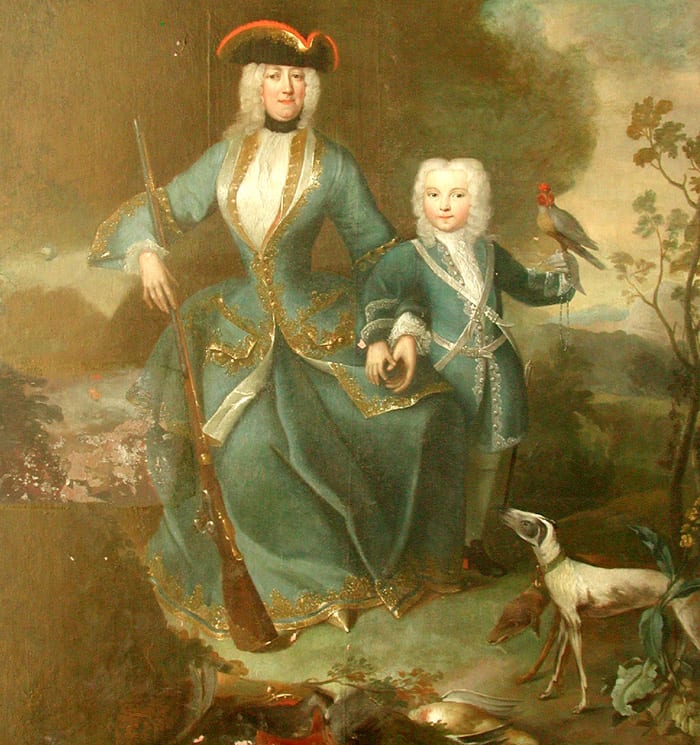
Eleonore von Schwarzenberg and her son. She loved to hunt, but would never kill a wolf
Another painting portrays Eleonore von Schwarzenberg (1682-1741), the “Vampire Princess” who is said to have inspired Bram Stoker’s Dracula. For years, Eleanor suffered from a mysterious wasting malady that rendered her pallid, frail, and incapable of producing an heir. Desperate and superstitious, Eleonore spent enormous sums of money on whatever “medications” were available at the time, and also began sending servants to obtain the milk of she-wolves, which was rumored to aid fertility. At age 41, Eleonore finally gave birth to a son, but her health continued to decline, especially after her husband was killed in a hunting accident. Citizens of Vienna, where she was residing at the time of her death, suspected that Eleonore was a vampire (apparently, vampirism was a thing in the eighteenth century) not only because of her ghoulish appearance and eccentric behavior, but also because when she died, her funeral and burial did not conform to tradition—especially for a member of a noble family. First, her physician performed an autopsy on the cadaver, which was highly unusual for the time. The procedure revealed a huge tumor near her intestines, probably an indication of what we now recognize as cervical cancer—which accounts for the decades of ill health. In addition, both Eleonore’s funeral and her burial took place after dark, with no clergy and no family members in attendance; per a request in her will, only commoners were invited. Initially, she was interred in a small chapel with soil from the churchyard, but later she was reburied in Česky Krumlov’s St. Vitus Church, under a concrete slab marked with a skull and crossbones. (Was the heavy slab intended to prevent her from rising from the grave for nocturnal excursions? What do you think?)
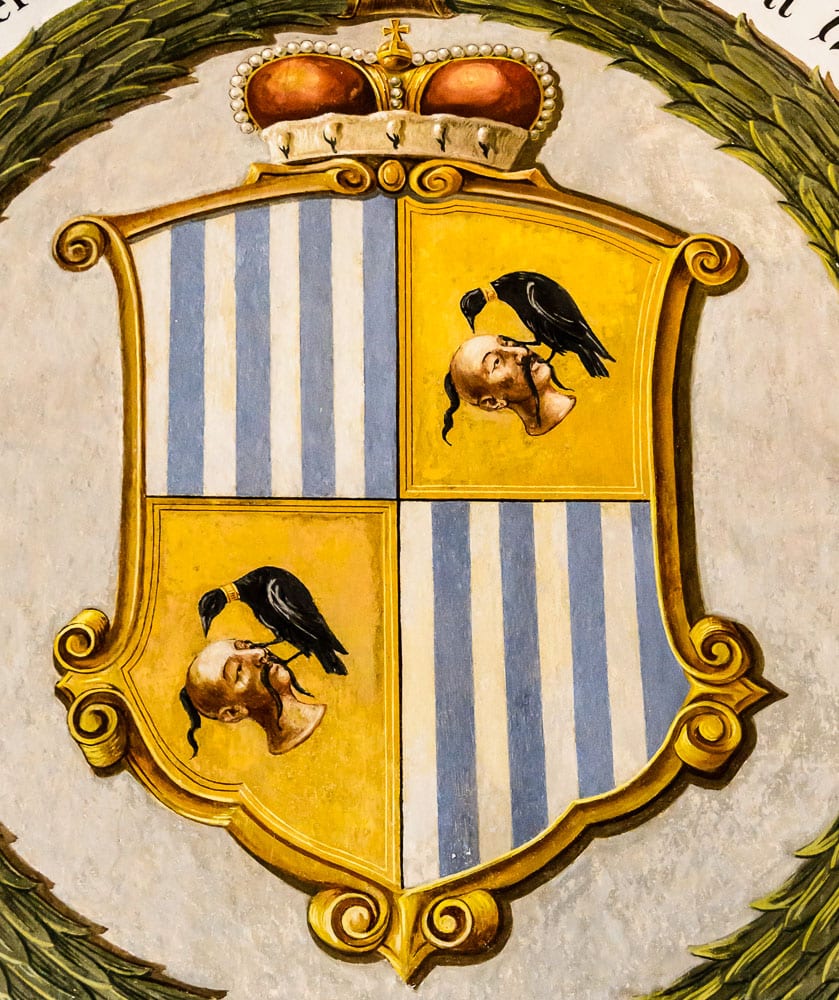
Schwarzenberg coat of arms
Equally macabre is the Schwarzenberg coat of arms, which appears in both sculpted and painted form all over Česky Krumlov. Its most distinctive element depicts the bald head of a moustachioed man with a raven pecking out its eyes. Clara told us that the curious image commemorates the Schwarzenbergs’ successful conquest of a Turkish fortress during the sixteenth century.
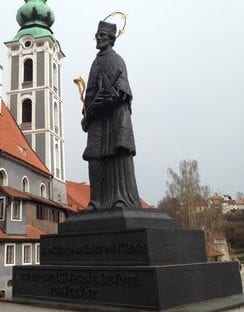
St. John of Nepomuk, patron saint of the Czech Republic
Another, much less disturbing image that we saw throughout the castle was that of one the Czech’s patron saints, John of Nepomuk. St. John is credited with saving the Schwarzenberg line from extinction. As the story goes, a duke and duchess who had been estranged for fifteen years after their union produced several daughters but no sons, met again by chance on St. John’s Day. Inspired to forget their grievances, the couple reconciled and soon produced an acceptably male heir.
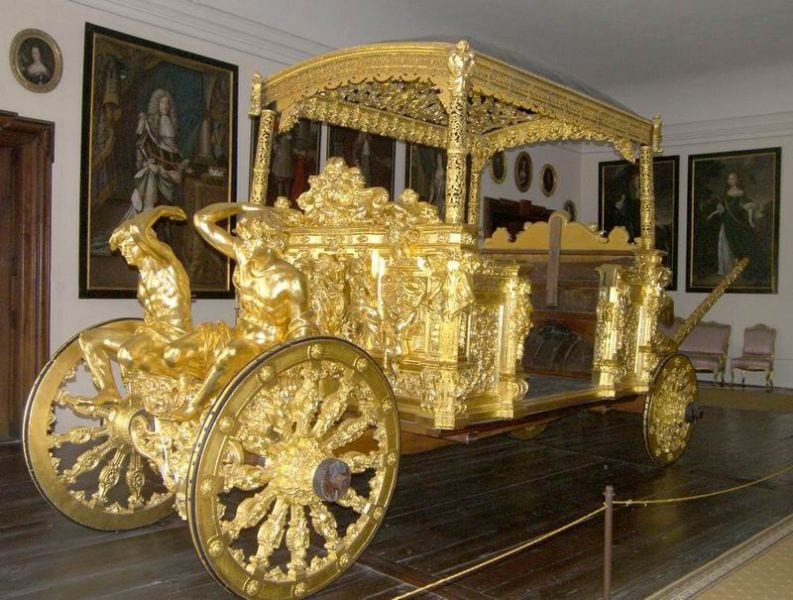
The golden carriage that bore gifts to the Pope
Probably the most stunning artefact in the castle is an elaborately carved, gold-plated, rococo carriage that had been the centerpiece of a 1638 procession conveying gifts to Pope Urban VIII from Ferdinand III, a Habsburg prince who had just become Holy Roman Emperor. Ferdinand III chose an Eggenberg duke as his official envoy, hoping the wealthy nobleman would make a favorable impression on the Vatican. The Pope accepted the gifts, but the Eggenbergs retained the carriage.
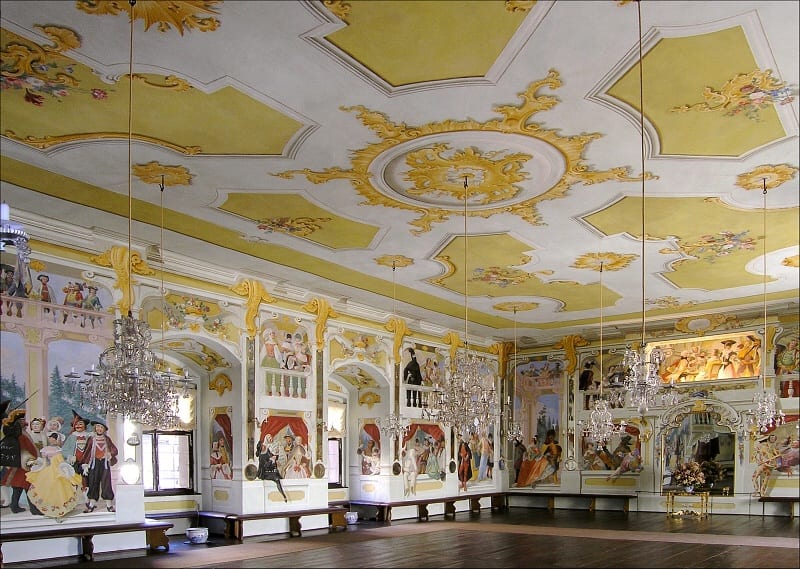
The Masquerade Hall
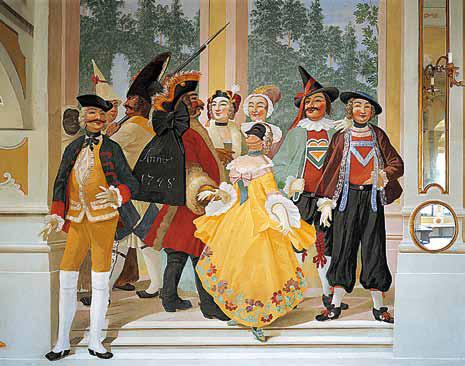
Detail from the Masquerade Hall
The last room on the tour was the most delightful. The Masquerade Hall, built in 1748, needs no occupants to feel alive with guests and entertainers because its walls and balconies are covered with trompe l’oeil paintings depicting gaily costumed revelers—along with the musicians and actors ready to entertain them.
We thanked Clara for a very informative tour and then exited the castle by way of a ramp that gave us a fabulous view of the medieval village straddling the river below.
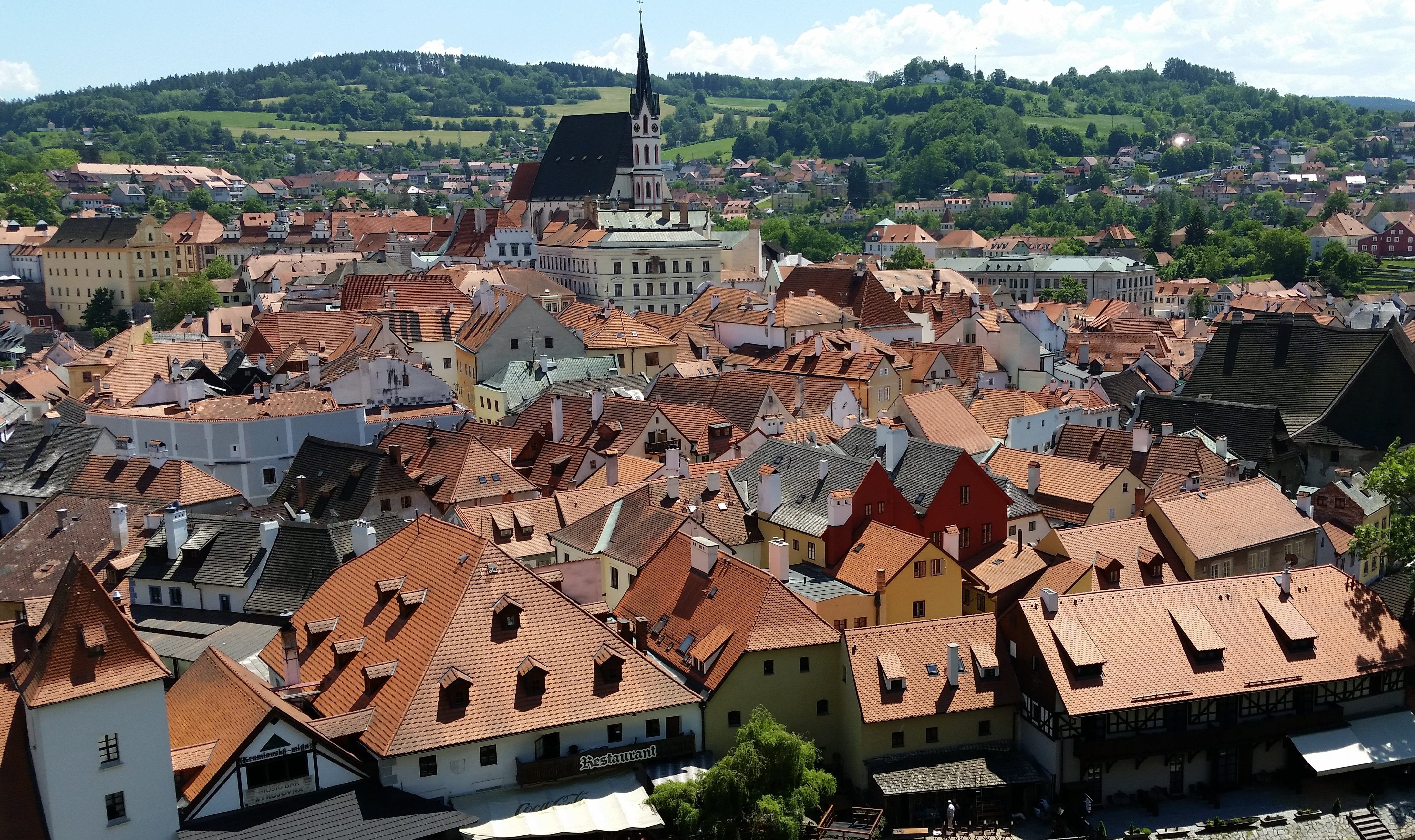
View of the town from the castle
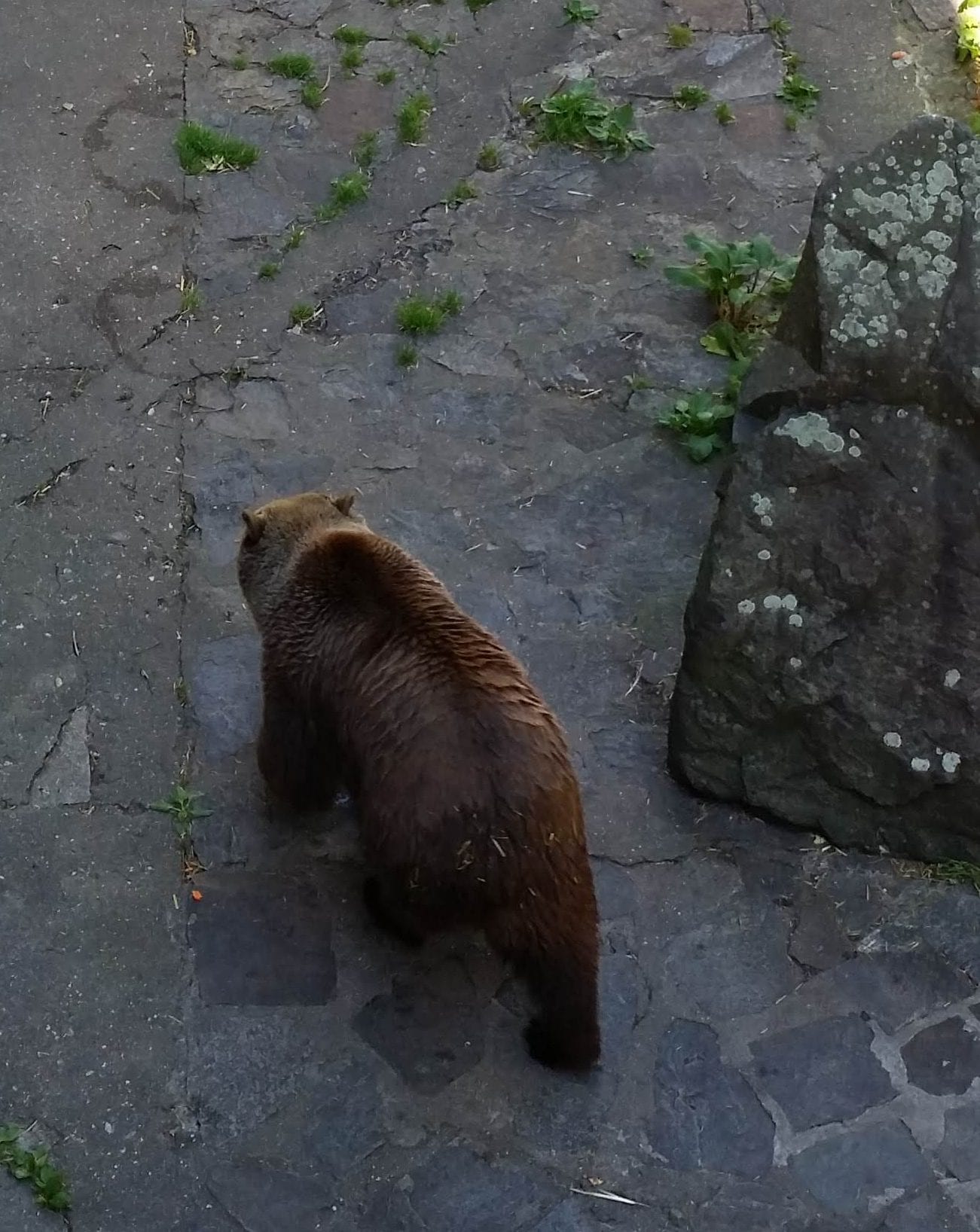
One of the moat’s current residents
Crossing the castle moat, we caught glimpses of the live bear that roams within its confines. Before they were killed off by hunters during the nineteenth century, bears had been common in the Sumava Mountains south of Česky Krumlov, and the Rosenbergs apparently had a particular fondness for them. Bears not only appear holding up shields on the family’s coat of arms, but by 1707, bears had begun to constitute the castle’s first line of defense as residents of the surrounding moat.
Captive bears lived in the moat off and on during succeeding centuries, but after the area’s wild bear population declined, it became harder to replace them. In 1857, after a long period when the moat went uninhabited, a breeding pair was brought in from Transylvania and a bearkeeper was employed to take care of them. Since the castle passed to national ownership, bears have been acquired from zoos and through donations. Recently, the moat was reconstructed to make the enclosure appear more like part of the natural landscape, and to meet the modern requirements of a comfortable environment for the animals, with trees, a lagoon, and toys.
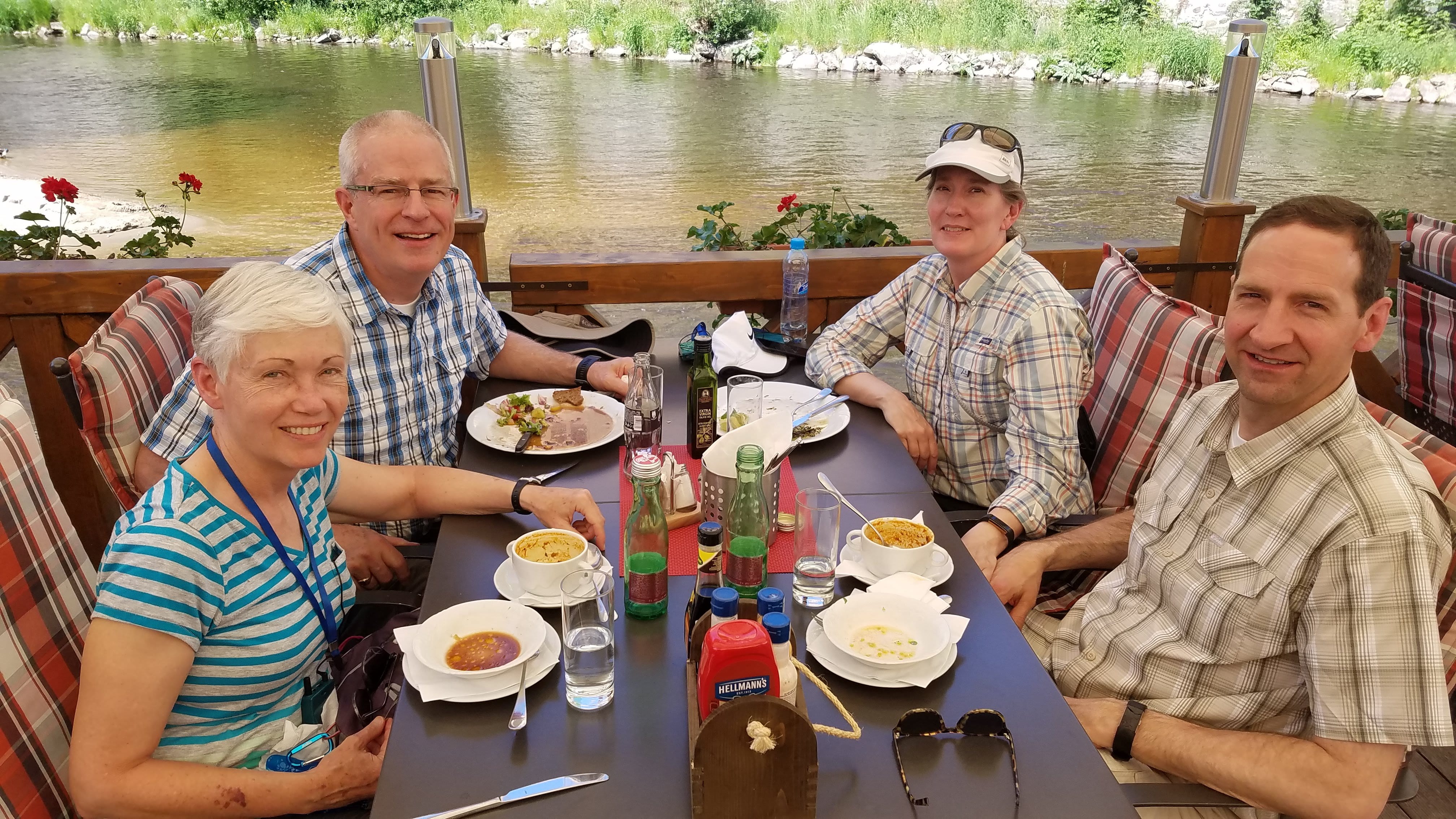
Lunch on the Vltava at the Dvořák Hotel with Lisa and Ed
Hungry by the time the castle tour ended about 1:15, our group broke up and scattered to find lunch. Along with Ed and Lisa, we headed toward the outdoor cafe at the Hotel Dvořák, wedged along a bank of the Vltava just across from the castle. Knowing that we had dinner reservations at a nice restaurant back in Prague tonight, we tried to not overdo lunch. Nancy had a bowl of traditional goulash (which tasted almost exactly like what she makes at home) and Michael had a salad with grilled chicken. The food was good, the conversation better, and the setting was out of this world—or at least out of our twenty-first-century world, until a group of tourists came spiraling down the river in their rented, Day-Glo kayaks.
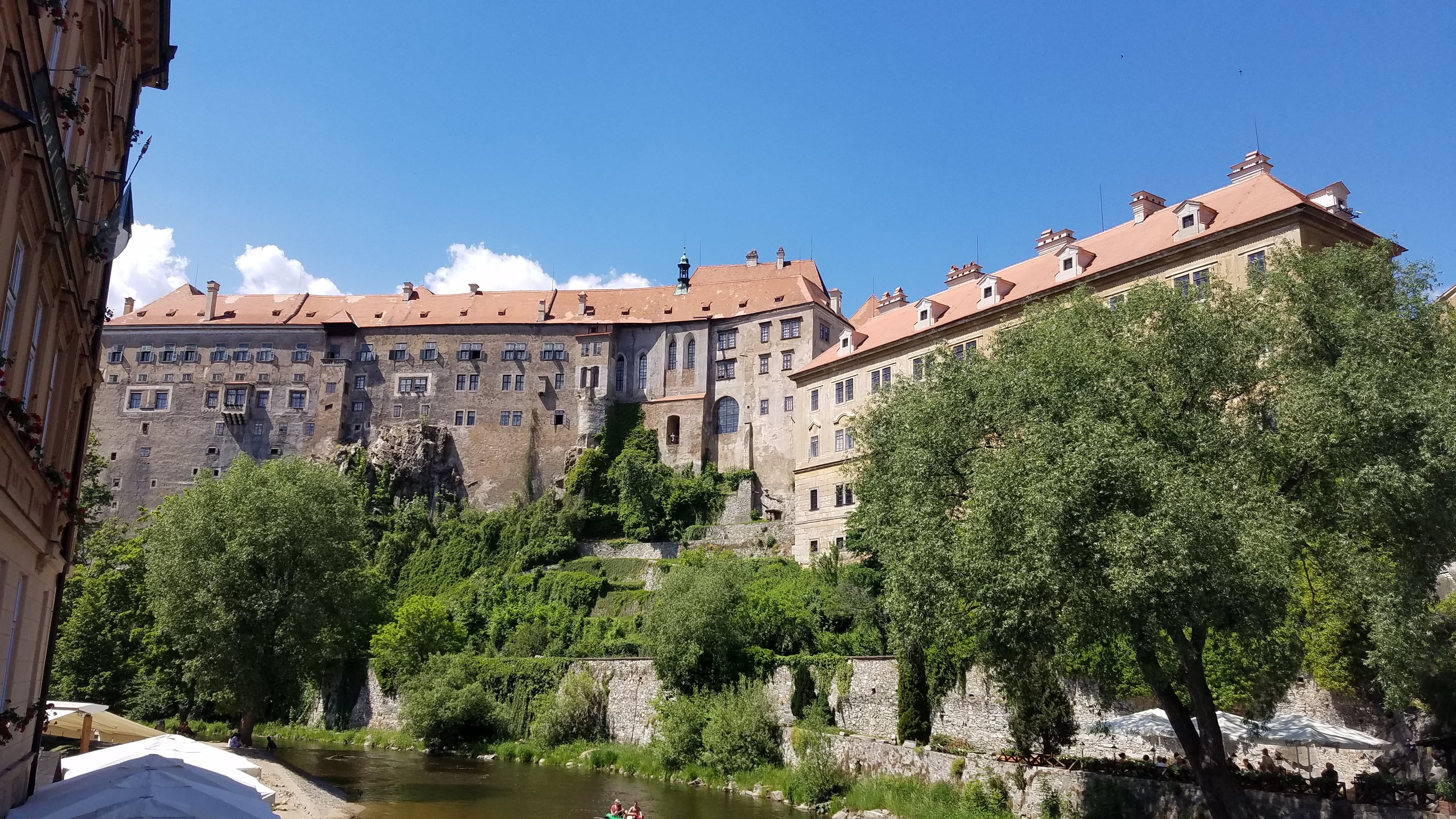
The view from our lunch table. (Note the kayak at the very bottom)
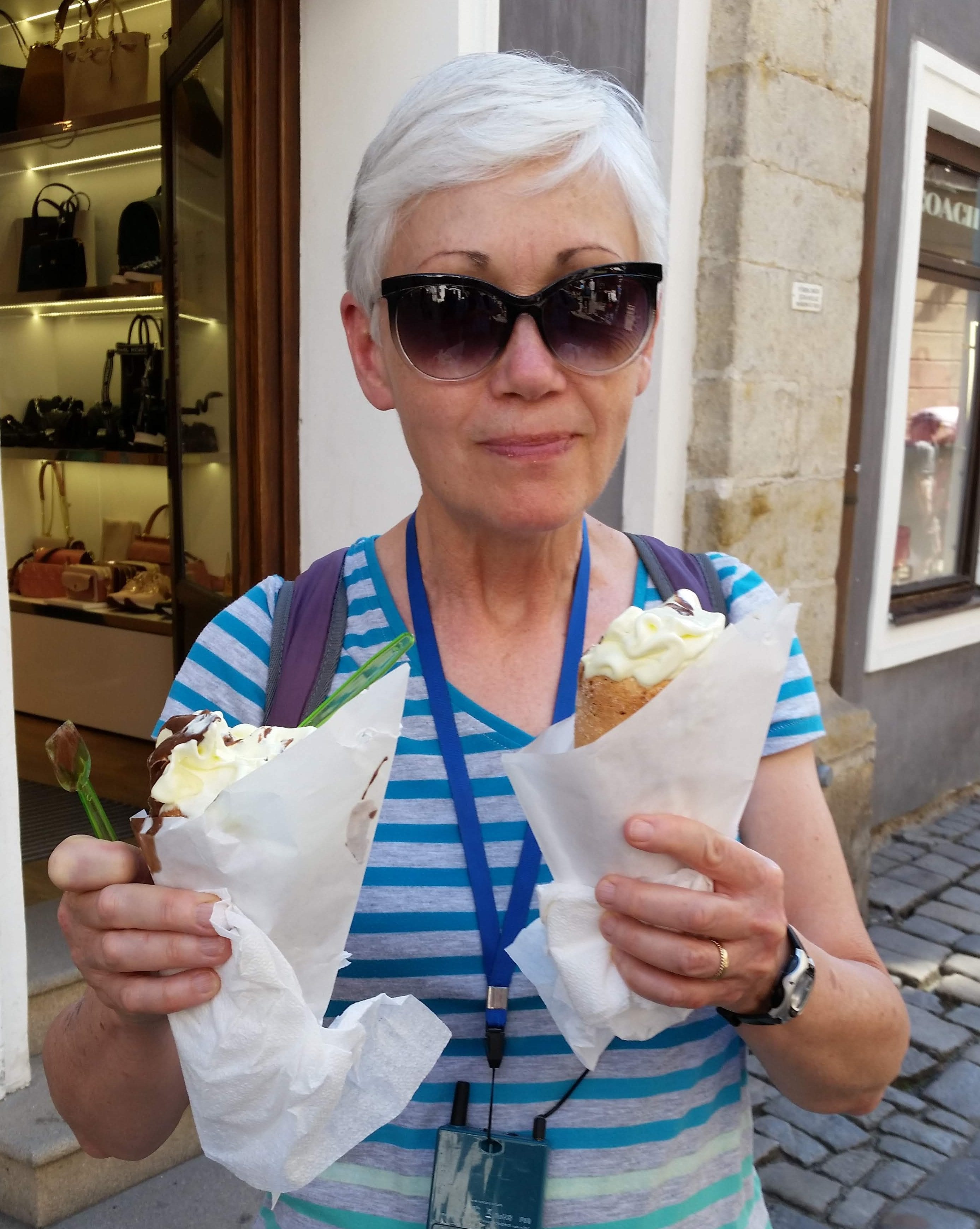
Chimney cones
Instead of ordering dessert at the cafe, we sought out a shop that sold “chimney cones,” a local specialty featuring ice cream within a cinnamon-flavored, cylindrical pastry. The soft-serve ice cream was nothing special, but the crisp, flaky pastry was. (Why has no one tried to market this in the US? With better ice cream, chimney cones could be a big success.) Nancy didn’t really mind the mediocre soft-serve because, while trying to simultaneously take a bite and a photo, she dropped her cone and lost most of the filling. The retrieved pastry was still delicious!
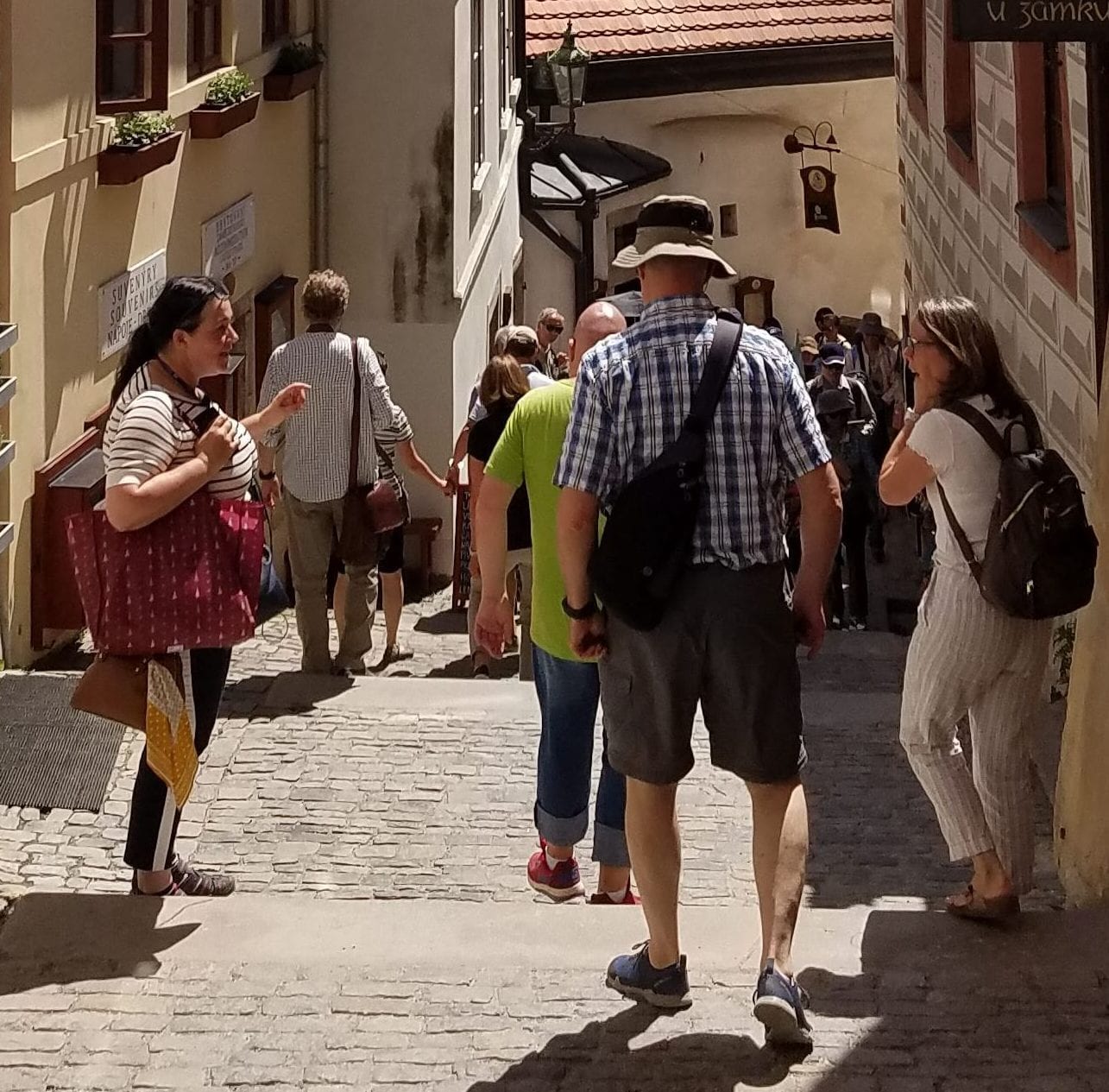
Eva (left) continues her commentary as we walk through the medieval town
After lunch, we regrouped and Eva took us on a walking tour of the lower town, center of commerce for the castle. This feudal town was founded in the Middle Ages and has undergone Renaissance and Baroque transformations. Spared from the conflicts of the great world wars, it has remained almost intact, retaining its layout of streets and many of its old buildings with their colorful facades and vaulted spaces.
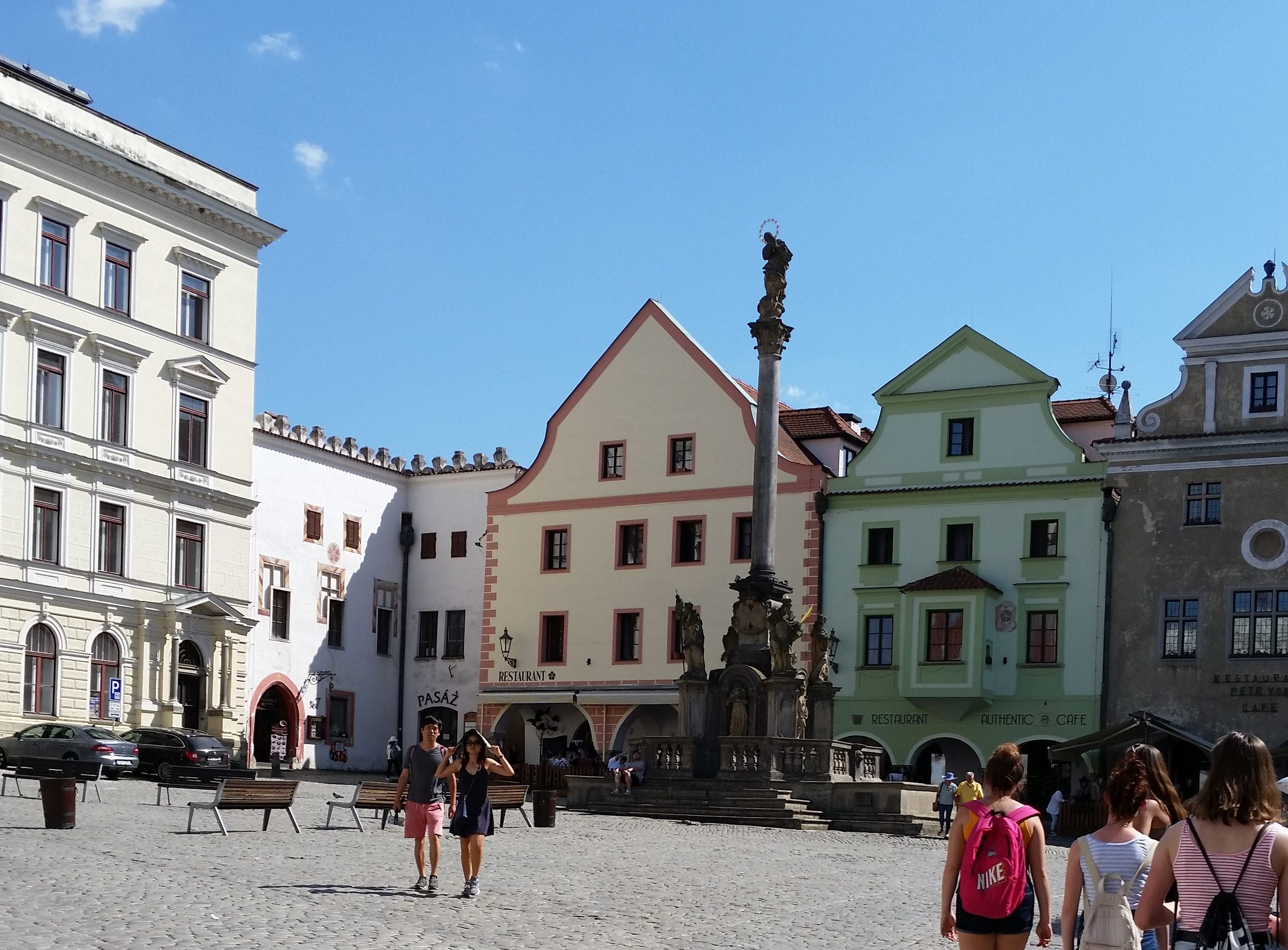
Cesky Krumlov’s town square with another statue of St. John
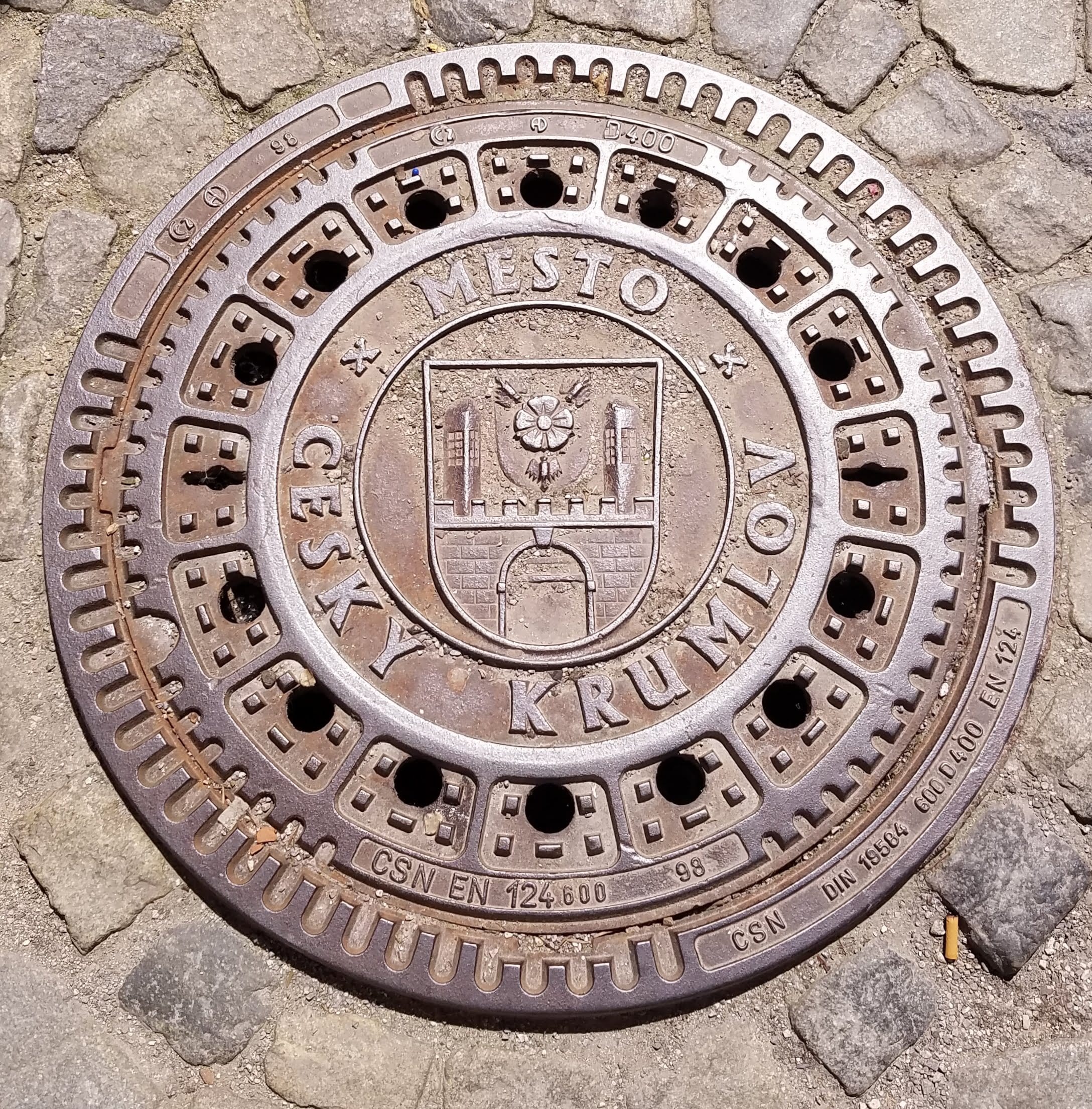
Local manhole cover
Our group had agreed to meet our guide at the entrance to the castle gardens at 2:45, but it was considerably later by the time everyone reassembled, so we had only a few minutes to enjoy the fountains and the blooming roses before heading down the hill to meet our bus driver.
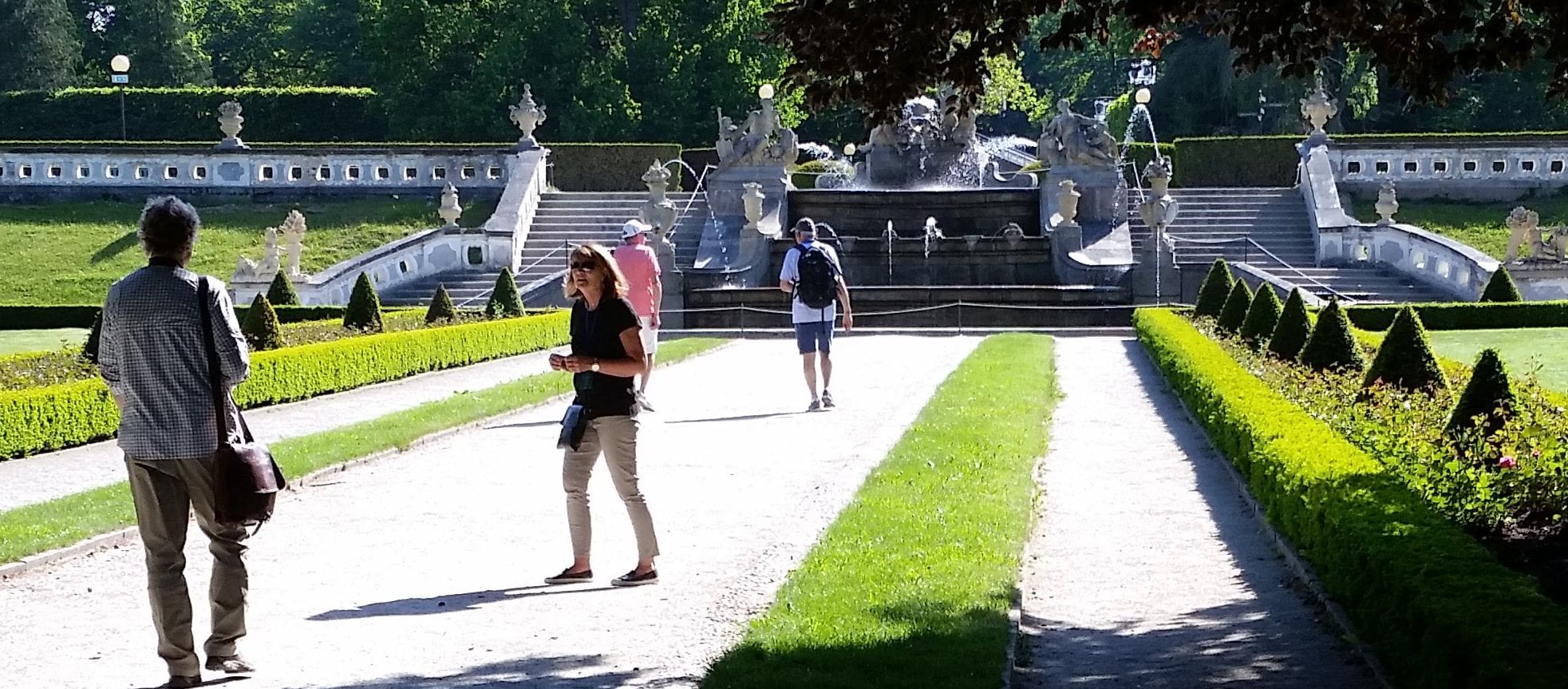
Castle gardens
Michael was anxious to get going on our journey back to Prague because he not only had reserved a 6:00 p.m. seating for six at one of the city’s best restaurants, but had paid a sizeable, nonrefundable deposit for the table. The reservation at V Zátiší had been made weeks ago, based on a recommendation from Katie’s sister (“The best meal I had in Prague–or maybe anywhere”), long before we knew about the itinerary change that took us to Česky Krumlov today. When we explained the dinner situation to Eva, she told us that the timing of our castle tour would make it impossible for us to get back to Prague by 6:00, but she agreed to call the restaurant and try to arrange a later seating for us. She succeeded in reserving a table for 8:00 p.m., but still we would have to hurry. We knew the return trip would take at least 2.5 hours, and should we encounter heavy traffic once we reached the outskirts of Prague, it could take considerably more.
Mix-ups about where to meet the bus resulted in more agonizing delays before we finally got on the road back to Prague about 5:00 p.m. We did not return by the same highways we had taken this morning, however; whether because Eva wanted us to see different aspects of her beloved Bohemia or because the bus driver was trying to avoid traffic, we weren’t sure.
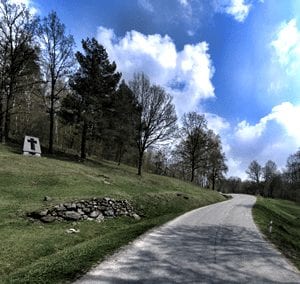
Winding roads in the Czech highlands
What was certain was that the driver was not taking the most direct route recommended by Google Maps (which Michael was following), and that he was propelling us along narrow, winding backroads at the same speed he had driven on the expressway. Everyone on board soon began to feel more than a bit queasy.
“This is like Mr. Toad’s Wild Ride,” Michael remarked, and other green-faced passengers nodded in agreement. The fact that the bus’s air conditioner couldn’t keep up with the late-afternoon heat didn’t help.
It’s been so long since Nancy experienced any kind of motion sickness that she can’t remember the last occasion, but about 90 minutes into this afternoon’s journey, she recognized the signs.
“I’m afraid I’m going to be sick,” she murmured to Michael. Fortunately, she managed to locate the plastic treat bag Eva had passed out earlier, just in time to discreetly refill it with the contents of her upset stomach.
The tortuous ride came to an abrupt end when we encountered a logging truck that also had lost its load while trying to negotiate a curve. The truck blocked the whole road, which was too narrow to allow the bus to turn around. Other cars were backed up behind us, so all we could do was wait for the logs to be reloaded so the truck could move out of the way.
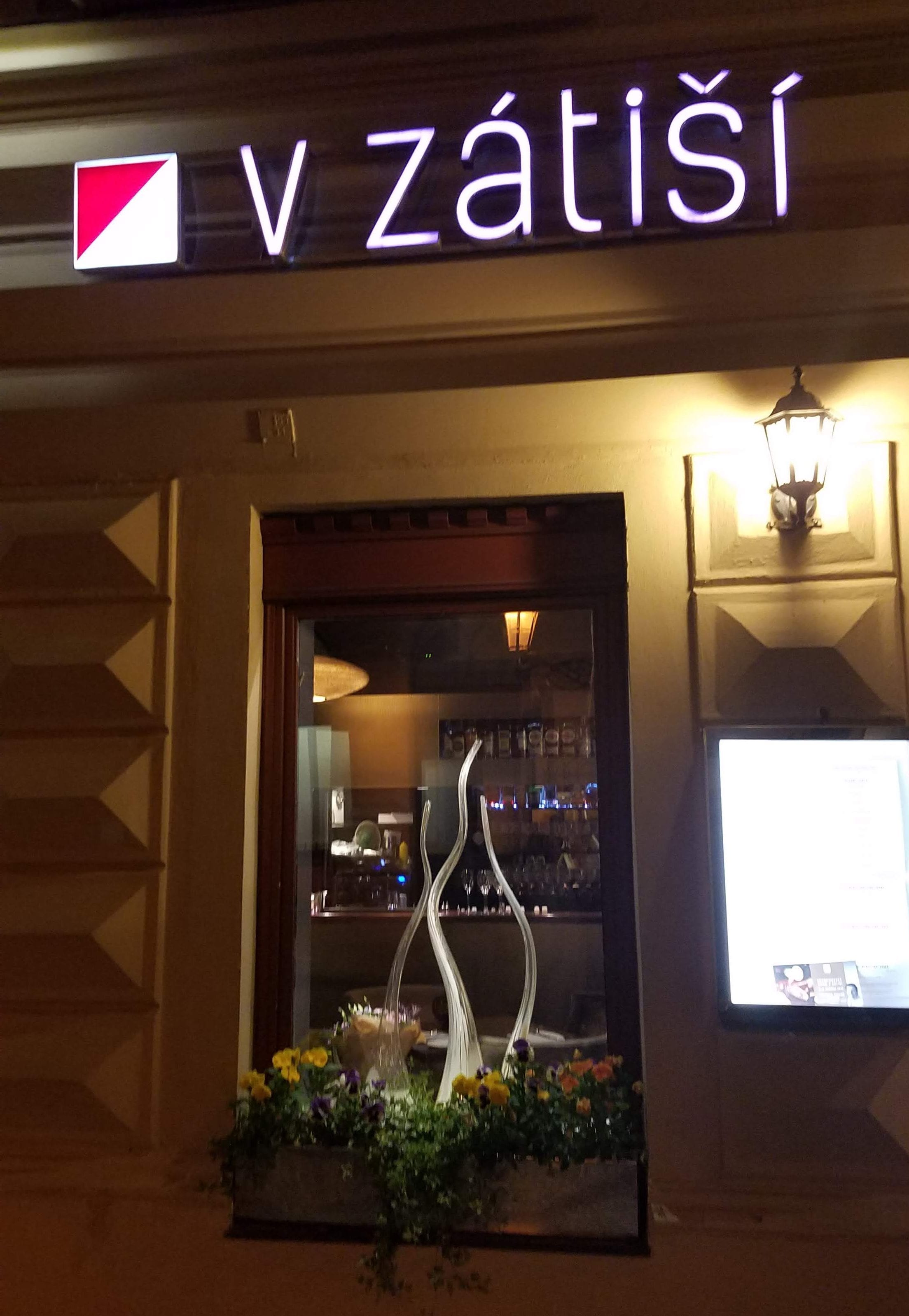
One of Prague’s top-rated restaurants
When we resumed our journey, Michael estimated that we might be able to arrive on time for our dinner appointment if the bus dropped us off at the restaurant instead of at our hotel. But did V Zátiší have a dress code? All of us were wearing casual travel clothes, with several men in shorts. We asked Eva to call the restaurant again, and were relieved to learn that we could come as we were. We also were grateful that those who were not planning to dine at V Zátiší tonight were willing to accommodate our needs and wait a few more minutes before they got back to the hotel.
We entered the restaurant at 8:05. Mission accomplished!
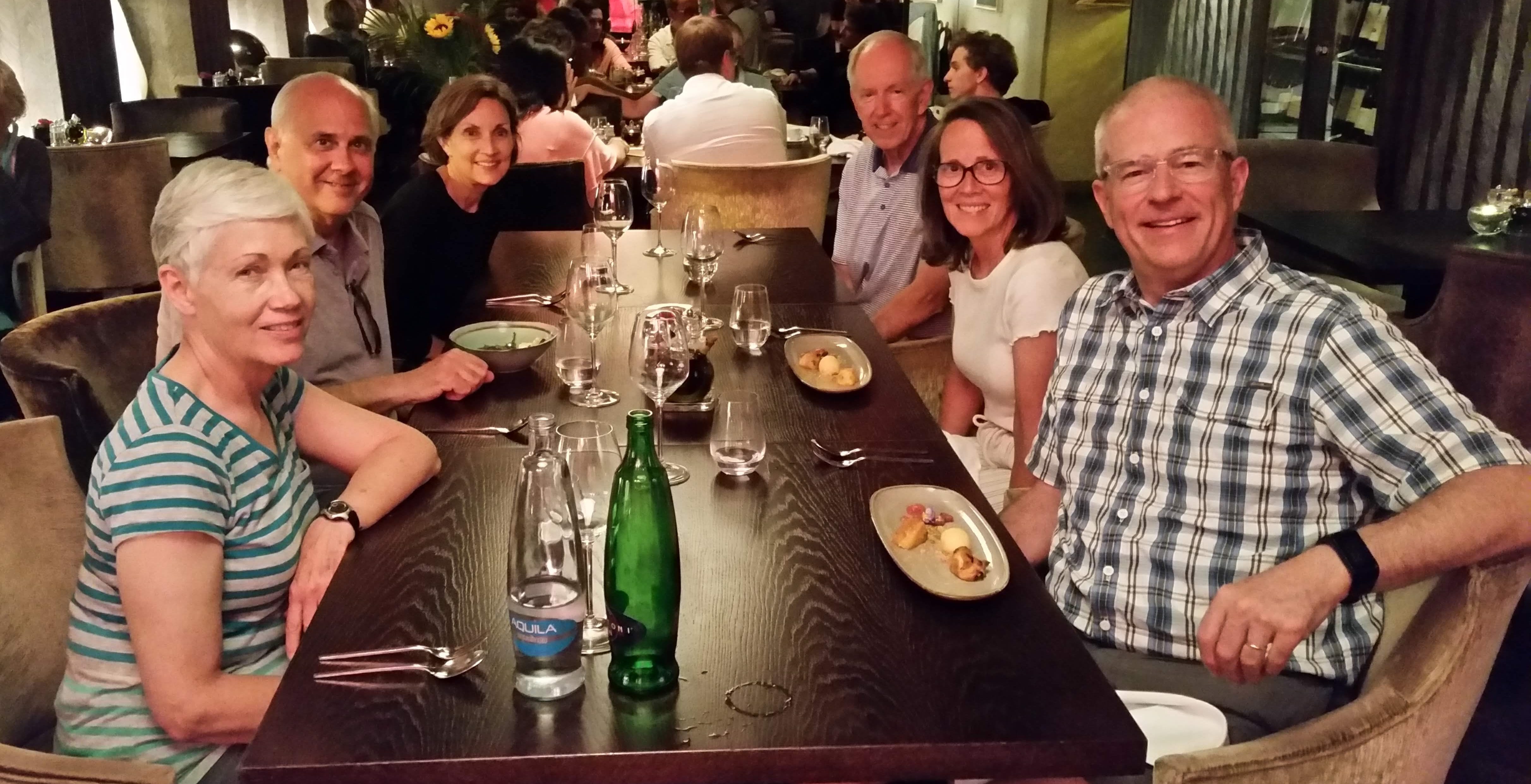
Nancy,Tony, Linda, Budge, Katie and Michael
After being shown to our table, we took the liberty to go to the restroom and wash up. V Zátiší is Czech for Still Life, so when the six of us finally were seated in the plush yet modern dining room with menus in hand, we seemed to collectively agree to put the wild, anxiety-filled bus ride behind us, breathe deeply, and focus on this particular moment in time. Indeed, Nancy, Michael, Katie, Tony, Linda, and Budge were about to have an extraordinary experience.
Our first task was to make sure we understood all the options on the menu, which included multiple fixed-price, fixed-plate selections. Pascal Favre d’Anne, a Michelin-starred French chef who happened to have taken over V Zátiší’s kitchen for the week, had created a special menu from which one was free to choose four, five, or all six set courses. The other two fixed-price options included a four-course traditional Czech menu and a five-course Indian-inspired menu (devised by V Zátiší’s regular chef). In addition, there were several a la carte items for those who preferred to choose their own starters, main plates, and desserts. Tony decided to go all-in and ordered Chef Pascal’s full six-course menu; Katie and Michael chose the Indian menu, and Nancy, Linda and Budge went a la carte.

Fixed-price Indian menu, with the tandoori tiger prawns
Michael’s Indian menu started with chilled tomato-coconut soup with pickled cucumber, followed by lime-chili tandoori tiger prawns with coconut rice and dollops of tamarind, mint-coriander, and garlic-tomato chutneys. His third course featured fillet of sea bass seasoned with ginger and garlic in peanut-lemongrass sauce, served with spinach potatoes and tomato-coconut chutney. His fourth course was Chicken Tikka Masala with basmati rice and cauliflower. He finished with a plate of warm tandoori pineapple with mirabelle sorbet. Nancy chose the shaved asparagus salad with cherry tomatoes and ricotta-mushroom croquette for her starter; lamb chops in marjoram crust with lamb confit, mint gnocchi, and green peas for her main plate, and chocolate fondant for dessert.
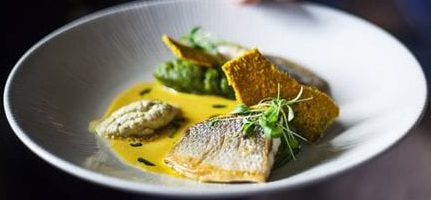
Sea bass
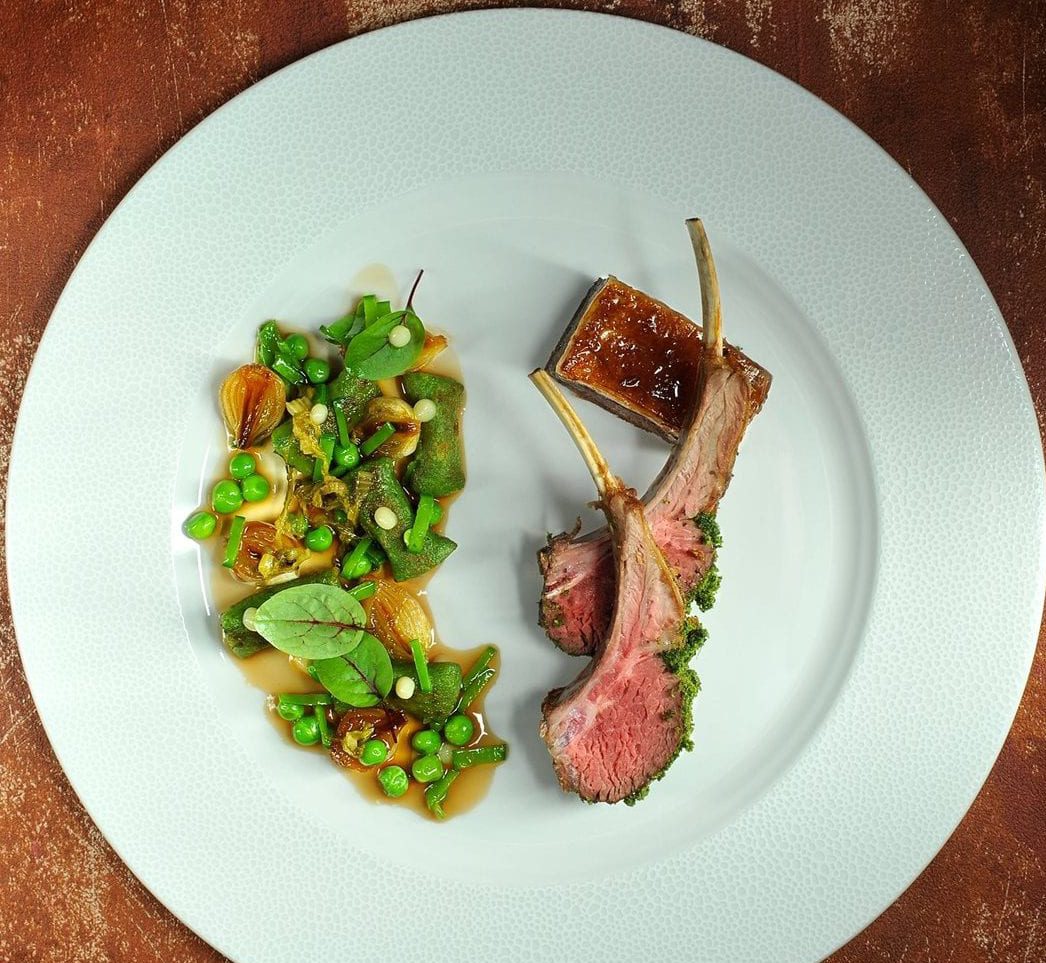
Lamb chops
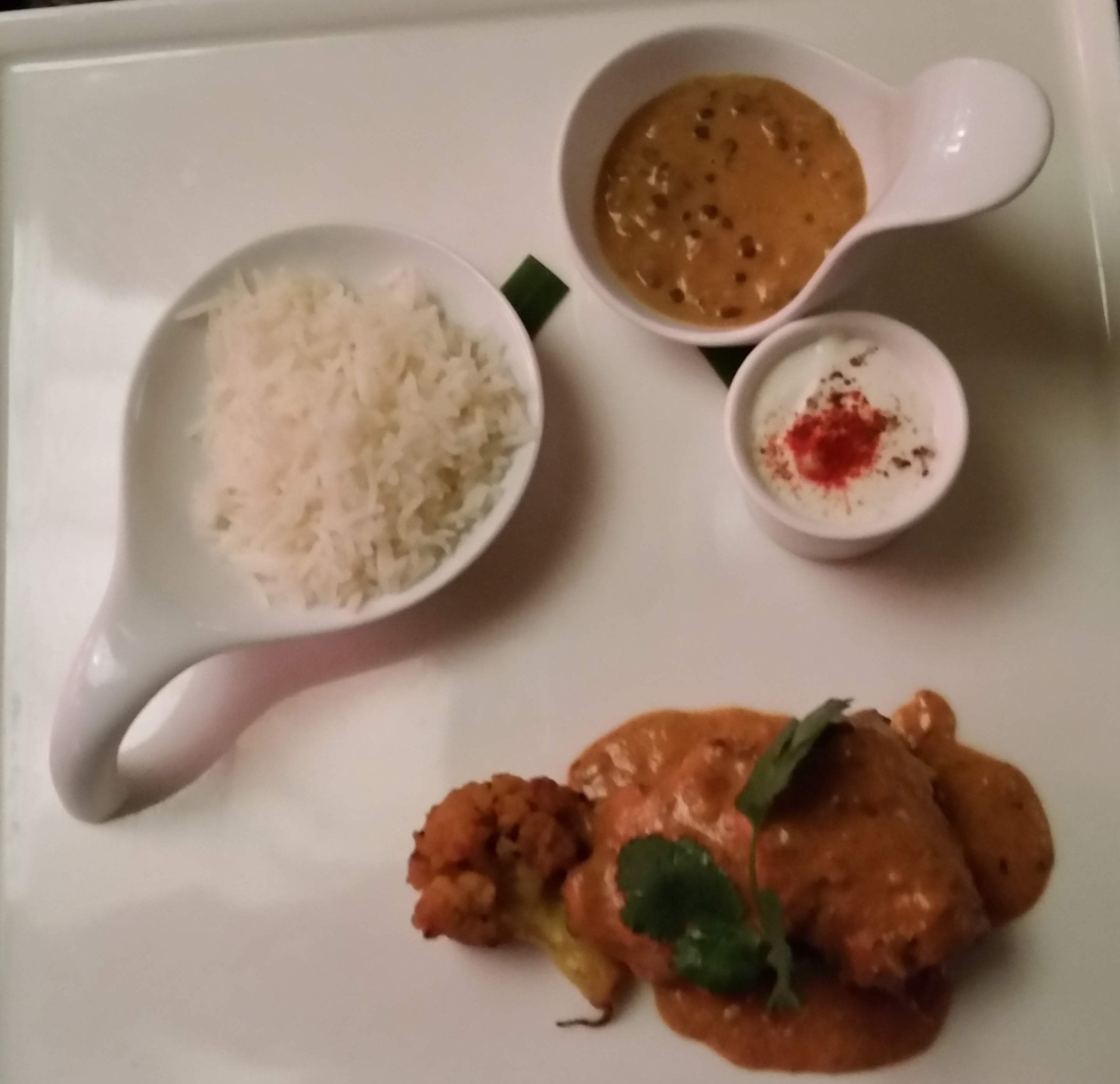
Chicken Tikki Masala
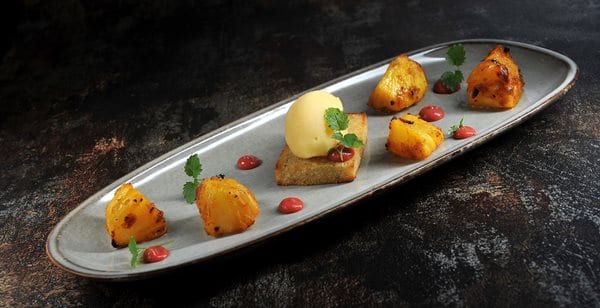
Tandoori pineapple
The whole experience—the people, the place, the food, the conversation—was blissful. The taste of every item elicited awe, wonder, and reverence. We shared and compared and felt blessed to be together. Even Budge and Linda, who never aspired to be the kind of hard-core foodies Tony, Katie, Michael, and Nancy claim to be, admitted that part of the pleasure for them was listening to the rest of us wax rhapsodic and to be enveloped within the same aura. It was one of those rare experiences in which everything was perfect—even though we had come imperfectly attired.
It was just before 11:00 p.m. when we left V Zátiší. The restaurant’s Still Life ambiance immediately gave way to a completely different vibe: the cobblestoned street outside was thronged with so many chattering, laughing young people—probably forty or fifty of them, some with drinks still in hand—that we had to walk single-file against the buildings until they passed. We don’t know where they had come from or where they were going, but it was obvious that they, too, were enjoying the companionship of friends and the magic of a warm, starry night. As we strolled back through Old Town’s narrow, pedestrian-only streets, our ecstasy persisted until we returned to the Hotel Paris, climbed the stairs, and fell into bed.
Leave A Comment